Women Who Changed the Face of Dentistry
The transition to gender equity in dental schools began in the 1970s. Fifty years later, U-M alumnae recall what it was like to lead the change.
For the University of Michigan School of Dentistry Community | Spring 2022
Dea n ’ s Message
Dear Alumni and Friends,
For my final Dean’s Message in M Dentistry magazine, I express my gratitude to the many dedicated and devoted members of the School of Dentistry community

I have met as I led the school over the last nearly nine years. Super-smart and resilient students. Highly accomplished and collaborative faculty. Innovative and relentless researchers. Supportive and resourceful staff. Enthusiastic and generous alumni. Creative and cooperative corporate partners. I have felt incredibly fortunate to partner with amazing colleagues and friends.
Becoming Provost of the University of Michigan was not what I expected in 2022 as I neared my 10th and final year as Dean. An opportunity to explore and further serve this great University, was simply something I couldn’t pass up. I welcome the opportunity to work with President Mary Sue Coleman during this time of leadership transition. My connections to the School of Dentistry community will remain strong, as I retain my professor appointment at the school during and after my time as Provost is complete.
When I began as Dean in 2013, most of the announcements and articles mentioned that I was the first woman to be named dean since the school was founded in 1875. So it is a fitting coincidence that our cover story in this issue looks at the trailblazing women who were dental students in the 1970s. It was the decade when the number of women in our DDS classes – and at other dental schools, too – began to increase significantly. From the days of just one or two women enrolled each year, women now consistently comprise 50 percent or more of our entering DDS classes. That means, moving forward, that the number of dentists who are women nationally is going to steadily increase from the current 35 percent to 50 percent or more. My hope is that many more women in dentistry will pursue opportunities in leadership in coming years so that a woman being named Dean is unremarkable.
Leadership, to put it simply, is challenging but rewarding on so many levels. Experiencing the engagement and loyalty of our alumni network has been one of my greatest pleasures in my role as Dean. Wherever I went from coast to coast, I found people who believe in advancing excellence in dentistry through our school. Whether I was meeting with alumni at state and national conferences, fundraising events, or small alumni social gatherings, I have been continually impressed by the camaraderie and support you have demonstrated toward your alma mater. I know that your commitment will carry into the future with whomever becomes the new dean.
Kind regards, stay well and Go Blue!
Laurie K. McCauley, Dean William K. & Mary Anne Najjar Professor
M Dentistry is published twice a year for alumni, students, faculty, staff and friends of the School of Dentistry. See the school website at www.dent.umich.edu for more news and features.
Dean …Laurie McCauley Director of Marketing & Communications Raymond Aldrich Writer/Editor Lynn Monson
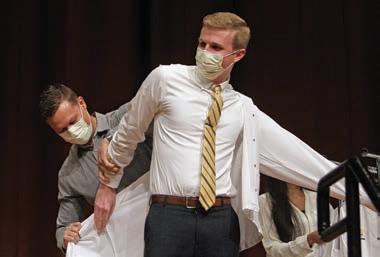
Designer/Graphics Ken Rieger
Photographers Leisa Thompson, Lynn Monson, Ken Rieger
University of Michigan School of Dentistry
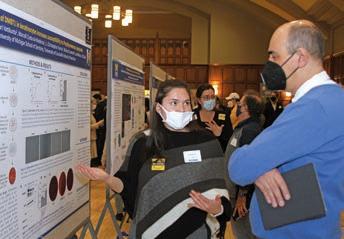

Alumni Society Board of Governors:
Terms Expire Fall 2022:
Janet Cook, BSDH ‘81, Whitmore Lake, Mich.
Gerald Dietz Jr., DDS ’84, Bloomfield Hills, Mich.
Julia Johnson, BSDH ’12, Commerce Twp., Mich.
Bruce Lee, DDS ’87, Traverse City, Mich.
Chair: Andy Lewis, DDS ‘98, Seattle, Wash.

Janice Pilon, DDS ’93, Hanover, N.H.
Terms Expire Fall 2023:
Karen Beckerman, BSDH ‘95, Plymouth, Mich.
Jake DeSnyder, DDS '67, Plattsburgh, N.Y.
William Mason, DDS '81, MS '84, Saginaw, Mich.
Michael Palaszek, DDS '82, Grand Rapids, Mich.
Michelle Velez, BSDH ‘98, Royal Oak, Mich.
Lisa Wendling, DDS ‘93, MS ‘96, New Lothrop, Mich.
Terms Expire Fall 2024:
Michael Behnan, MS ‘79, Rochester Hills, Mich.
Theresa Hull, BSDH ‘11, Ann Arbor, Mich.
Sara Kellogg, DDS ‘07, Saline, Mich.
Amin Jaffer, DDS ’97, Ann Arbor, Mich.
Mona Riaz, BSDH ’12, MS ‘20, Farmington Hills, Mich.

Riley Schaff, DDS ’17, Ann Arbor, Mich.
Ex Officio Members: Laurie K. McCauley, Dean Carrie Towns, Director, Alumni Relations and Development
The Regents of the University: Jordan B. Acker, Michael J. Behm, Mark J. Bernstein, Paul W. Brown, Sarah Hubbard, Denise Ilitch, Ron Weiser, Katherine E. White, Mary Sue Coleman (ex officio)
Send comments and updates to: dentistry.communications@umich.edu or Communications, School of Dentistry, 1011 N. University Ave., Ann Arbor, MI 48109-1078

The University of Michigan, as an equal opportunity/affirmative action employer, complies with all applicable federal and state laws regarding nondiscrimination and affirmative action. The University of Michigan is committed to a policy of equal opportunity for all persons and does not discriminate on the basis of race, color, national origin, age, marital status, sex, sexual orientation, gender identity, gender expression, disability, religion, height, weight, or veteran status in employment, educational programs and activities, and admissions. Inquiries or complaints may be addressed to the Senior Director for Institutional Equity, and Title IX/Section 504/ADA Coordinator, Office of Institutional Equity, 2072 Administrative Services Building, Ann Arbor, Michigan 48109-1432, (734) 763-0235, TTY (734) 647-1388. For other University of Michigan information call (734) 764-1817.
© 2022 Regents of the University of Michigan
In this Issue 2 13 26 28 30 20 22 2 FEATURES DDS Gender Equity History 13 SCHOOL New POM Chair 20 FACULTY Profile: Dr. Darnell Kaigler, Jr. 22 RESEARCH Research Day 2022 26 DENTAL HYGIENE Larger Class Size 28 STUDENTS White Coat Ceremonies 30 ALUMNI Profile: Kamodia Family FEATURES SCHOOL FACULTY RESEARCH STUDENTS ALUMNI DENTAL HYGIENE Spring 2022 Volume 3 8, Number 1
FEATURES Women Who Changed the Face of Dentistry
The transition to gender equity in dental schools began in the 1970s.
Fifty years later, U-M alumnae recall what it was like to lead the change.
June 2022 marks the 50th anniversary of a landmark piece of Congressional legislation that jump-started one of the most significant changes in the history of dentistry and dental education.
When Congress passed Title IX of the Education Amendments of 1972, known simply as Title IX, it marked the beginning of the end of dentistry as a male-dominated profession. The law prohibited sex discrimination in programs and activities offered by educational institutions receiving federal financial assistance, including local school districts, colleges, universities and libraries, among others.
Today, at a time when the nation’s dental schools are admitting and graduating as many women as men – and, often, more – this year’s milestone serves as a reminder that gender equity is a relatively new development not only in dentistry, but in other professions and higher education in general.
Current discussions of Title IX often focus on athletics and the requirement that universities provide an equivalency of athletic opportunities and teams for women and men. But when Title IX was passed in 1972, it was focused on much broader educational inequalities and opportunities for women. It is easy to overlook that for most of the 20th century, attending college of any sort was something that women did in significantly lower numbers than men. The discrepancy was especially pronounced in the professional schools of medicine, dentistry, law and engineering where women usually comprised only 1 or 2 percent of the classes for many decades.
By the late 1960s and early 1970s, societal norms were changing in many ways, and the women’s rights movement and Title IX opened new doors for women. A U.S. Department of Justice report produced in 2012 for the 40th anniversary of Title IX put it this way: “Before
Title IX, women were often excluded from or had only limited access to educational programs. Elite colleges and universities set quotas for the admission of women or prohibited them from attending altogether; those that accepted applications from women often required higher test scores and grades for their admission.”
In the early days of dentistry, as it evolved into a profession in this country in the mid- to late-1800s, women regularly attended dental school, if not in large numbers. For example, in 1880, only five years after the University of Michigan School of Dentistry was founded, Alma Fuellgraff became the first woman to graduate from the school. In 1890, U-M earned the distinction of graduating Ida Gray, the first Black female dentist in the country. During the school’s first 30 years or so, as with many dental schools at the time, most classes included at least one woman, sometimes two or three.
However, as dental school class sizes grew across the country in the early 1900s, the number of women did not follow along. For decades, the larger classes settled into a pattern of only one or two women, or maybe none. U.S. Census data shows that women comprised 2.7 percent of dentists in 1900, increasing slightly to 3.2 percent in 1910 and 1920. But by 1930, the percent had dropped to 1.8, then to 1.5 in 1940. In the three decades from 1952-1979, women represented only 1.2 percent to 1.7 percent of U.S. dentists, according to the American Dental Association.
2 M Dentistry | Spring 2022 FEATURES
Marny (Guldemond) Williams | Class of 1970
By the time Marny Guldemond was in sixth grade in the mid-1950s in Mt. Clemens, Michigan, she knew she wanted to be a dentist. It was unusual for a girl to aspire to dentistry, but Marny had a role model in her family. Her father’s sister, who lived in The Netherlands, was the first female orthodontist in Europe and was married to a general dentist.
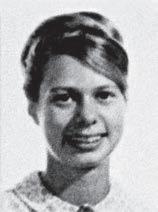
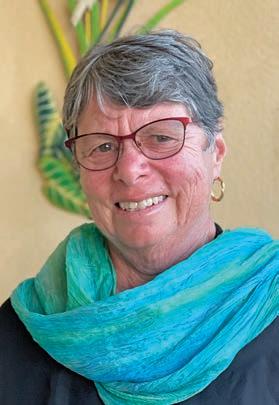
As a child, Marny idolized her aunt and uncle as attractive, smart and wealthy, figuring that dentistry could do similar things for her. Many years later she learned that her aunt and uncle’s wealth came from real estate investments, not from dentistry. “I actually made my sixth-grade career notebook on dentistry. I know that’s corny, but I wanted to be just like my aunt and uncle, and it never occurred to me that dentistry wasn’t their whole life.”
If her aunt could be a dentist, so could Marny. “I didn’t think about being a woman in dentistry,” she said. “I just assumed I was going to go to dental school.” She was accepted into the U-M School of Dentistry after her junior year as an undergrad at Michigan.
If the dental school had reservations about admitting women in the late 1960s, Marny came to her admissions interview armed with an idea suggested by a friend already in dental school. To demonstrate her hand skills, she carved tiny
As Title IX and national discussions about the role of women in society entered the landscape in the 1970s, the tide began to turn. It was a decade of sudden change at dental schools. At U-M, the Class of 1978 was the signature turning point, with 28 women, which was 18 percent of the class, a huge jump. Over the next 25 years, the number of women students per class increased steadily in most years. The goal of gender equity – a 50-50 ratio of men and women – was finally reached at the U-M dental school in 2004, more than a decade before the national average would reach 50-50 in 2017, according to the American Dental Education Association.
The dental school numbers translated to a rise in the number of women dentists nationwide. The steady rise began at 3 percent in 1982 to 9 percent in 1991, 16 percent in 2000, and 24 percent in 2010. As of the most recent survey in 2020, 35 percent of U.S. dentists are women, according to the ADA, and that percentage will keep growing to reflect current higher rates of women attending dental schools.
M Dentistry asked nine women who attended the School of Dentistry in the 1970s for their memories about being part of the decade when the gender equity movement began. They explain what led them to dentistry and what they remember about their time at the school. The final interview features the third-year student who is president of the Class of 2023, which entered with the most women (67) and highest percentage of women (61 percent) of any class in school history.
figures out of bars of Ivory soap – human figures, hands, people sitting in chairs. “I brought a box of those to show the dean for an interview,” she recalls. “I think the fact that I was really pushing it and pursuing it, and that I was really serious, got me accepted.”
Williams and one other woman had 90 male classmates and they were a good group. The faculty were another story, making dental school difficult for both men and women. “It was a humorless time,” she says. “We were terrified of them, we really were.” As for how the faculty treated women, she says, “I have to be honest – the faculty were a good old boys club.” One faculty member in particular was someone she purposely avoided because he seemed too interested in her. “It was upsetting.”
The solution for students was to help each other. “We were seated alphabetically, so I was Guldemond, then there was Kurt Hollweg and then John Howarth. The three of us were tight friends. And there were about six guys in the group and it became known as ‘Marny’s Army.’ They were hilarious. We were all really good friends. We studied together. We went to Florida together. We went out drinking together. We really had a good time. We got each other through it because dental school was not particularly friendly in those days.”
Williams went on to a lengthy career, practicing for 46 years in Gloucester, Massachusetts. In the early days of her career, she found that being a woman in dentistry was an advantage. “When I first went into the practice, they used me as an incentive for parents to bring their children for dental care,” she said. “It was a practice booster because it was unique back then. And even later, a woman dentist made the practice stand out in general terms as well.”
In retirement, she splits her time between Massachusetts and Florida, forever grateful for an aunt who served as a dentist role model all those years ago.
1970
Spring 2022 | M Dentistry FEATURES 3
Continued
Sharon Brooks found dentistry as a career in large measure because of her personal dental care needs. That women rarely went into dentistry never occurred to her. “I basically figured out what I wanted to do and said this is what I want to do, and did it.”
Sharon and her husband Dave, both Detroit natives, were living in Alaska in the late 1960s after she had earned a bachelor’s degree in elementary education at U-M. She worked as education director in a children’s home and at other jobs because traditional

teaching openings were scarce. As the young couple settled into their lives, Sharon decided it was time to deal with life-long dental issues that dated to her childhood growing up in a workingclass family with few resources.

“I never had good dental care when I was a kid because we never had any money,” she said. “And I never smiled because I didn’t want people to see my teeth.” She made an appointment with a dentist, who confirmed
that Brooks needed a considerable amount of dental work, including orthodontics from a specialist. Brooks was surprised at how she felt as the dental care progressed and her smile was transformed. “It made me feel so good to know that something was being done that I told Dave that I would like to be an orthodontist. He said, ‘What does it take?’” Brooks investigated dental school requirements and found that she had already taken much of the necessary science as an undergrad majoring in chemistry (and Russian). She took several courses in Alaska to meet the rest of the prerequisites and was accepted sight-unseen by the U-M School of Dentistry, with neither an in-person nor phone interview. Her stellar academic grades no doubt played a role in the easy admission, but it also seems likely that school administrators
FEATURES M Dentistry | Spring 2022 4 Women Who Changed the Face of Dentistry (Continued)
1875 0% 5% 10 % 20 % 30 % 40 % 50 % 60 % 1880189019001910 Percentage of Women Graduates in U-M DDS Classes, 1875-Present 19201930194019501960 6% 6% 3% 1% 1% 1% 0% 8% 8% 1970 – 2 women, 90 men 1971
1 woman, 82 men 1972
100 men 1973
4
113 men 1974
119 men 1975
134 men
132 men 1977
135 men 1978
124 men 1979
122 men The 1970s – Decade of Transition Actual numbers of graduating women and men per clas s Source: Data compiled from School of Dentistry graduation records, alumni lists and class composite graduation photos. Sharon Brooks | Class of 1973
–
– 0 women,
–
women,
– 3 women,
– 6 women,
1976 – 4 women,
– 14 women,
– 28 women,
– 17 women,
were aware that they had admitted a total of only one woman in the previous two classes. Brooks’ time with the Class of 1973 was mostly without problems related to being one of only two women in the original class. Two internationally trained female dentists joined in the second year to make a total of four women. She remembers only a couple of negative comments from male classmates. “One of them said basically that his father felt it was a crime that I was there,” she recalls. “It turns out this guy’s best friend didn’t get admitted and his father didn’t think that was fair. That was in our first year and that classmate never spoke to me again. I thought: that’s his problem.”
Over the course of dental school, Brooks’ initial interest in orthodontics switched to oral diagnosis and radiology. And she also changed plans from private practice to academia. The dental school offered her a job as a full-time clinical instructor, which she started two days after graduating with her DDS. She made a career at the dental school, teaching in clinic and classroom, earning three master’s degrees – one at the dental school and two in public health – and over time becoming the school’s leading expert in radiology. She edited and contributed to top radiology journals and lectured at conferences around the world, retiring in 2010.
Over her career, Brooks watched the tremendous growth in the number of women entering dental school and in the faculty ranks, but she doesn’t view herself as a trailblazer. “I have never been one of those who thought I was a pioneer,” she says. “My view was that this is what I want to do and I’m capable and I’m going to do a good job.”
And one last detail about Brooks’ journey as a woman in dentistry: The Alaska dentist who developed the treatment plan that ultimately caused Brooks to change her career track was Dr. Geraldine Morrow. Many years later, in 1991-92, Morrow became the first woman to lead the American Dental Association as president.
1973 FEATURES 5 Spring 2022 | M Dentistry Continued
1970198019902000 20212022202320242025 18% 35% 47% 47% 59% 52% 64% 2015 2018 52% 51% 2007 50% 2008 53% 2009 54% 2004 51% 51% Blue indicates years, starting in 2004, when women comprised 50% or more of a class PROJECTED 2% “My view was that this is what I want to do and I’m capable and I’m going to do a good job.”
Jessica Rickert | Class of 1975 Sandra (Manis) (Hock)

Jessica Rickert wasn’t intimidated by being one of only six women in a class of 140 when she entered the School of Dentistry in 1971. In high school and as an undergraduate at U-M, she had become accustomed to being the only woman, or one of only a few, in advanced science and math courses – subjects she had loved from an early age.
Growing up in a working-class family in Wyoming, Michigan, her future seemed more tied to her parents’ jobs as factory workers than to a profession like dentistry. A family pediatrician opened a new pathway.
Impressed by how many questions young Jessica asked during appointments, he let her visit his office to see how it operated. “One day he stepped back and looked at me and said, ‘You know, Jessica, I actually think you could be a doctor.’ I was 12 at the time, so that the first time that it came into my head that what I was studying in school that I loved – math and science – could lead to becoming a doctor.”
She chose dentistry over medicine after being accepted at both schools while at U-M. “It became more and more obvious to me that it was a fascinating field. It was very demanding yet provided excellent service and care to patients, and that’s what I wanted to do was care for patients.”
Once at the dental school, she and her five female classmates endured sexist remarks that faculty and male classmates pitched as supposedly humorous. Among the sentiment she heard was that each woman was taking the place of a man who would not be able to take care of his family. Or the women had taken the place of men who would then be drafted for the Vietnam War. Rickert said her standard procedure was to take whatever remark was aimed at her and throw it back at the offender. “I wasn’t going to stand there and take it,” she said.

Overall, though, she said the six women and their classmates were steadfastly focused on their studies. The Class of 1975 was the first to go through the brand-new dental school building for all four years. It was a beautiful setting with cutting-edge equipment, some of the top faculty in the world and, of course, fascinating science to be learned. There wasn’t much time to be worried or defensive about the male-tofemale ratio; dental school was about learning to be a dentist. “When I graduated in 1975, I felt I was prepared to go out in public and to be an excellent dentist and take good care of my patients,” Rickert said. After graduation, she and a classmate started a practice in Allen Park, Michigan. After six years, Rickert moved north to Interlochen, where she practiced for 34 years. She retired in 2010, then was a contract dentist with Michigan’s Department of Corrections for several years. Most recently, she has worked as a consultant for Delta Dental of Michigan to develop oral healthcare education programs for Michigan’s American Indian tribes. Rickert’s distinction as the first female American Indian dentist in the country is well-known in dentistry circles today, but the focus in dental school was on learning to treat patients and always putting their needs first – no matter the gender, race or other demographic of either the dentist or the patient.
“I was always impressed, and I’m still impressed, with the women in my class,” Rickert said. “They were very intelligent, they had a high skill level, they were very dedicated to their studies, full of compassion. They are women of integrity.”
Growing up in Dearborn, Michigan, Sandra Manis was the daughter of a dentist. Edward Manis graduated from the Northwestern University dental school in 1928 and practiced in Dearborn for 60 years, until he was 85 years old. Sandra’s mother, Jeanne, was his receptionist and assistant. Sandra worked in the office from the time she was 12, cleaning, sterilizing instruments, stocking supplies and eventually as a chairside assistant.
When it came time for college, Sandra headed to Purdue University for a degree in biology. “I didn’t aspire to be a dentist,” she said. “In my senior year when I faced the prospect of having to settle on a career, I wanted to go into teaching but there weren’t a lot of opportunities. My parents felt I was well-qualified to become a dentist based on my science degree and history of working in a dental office for so many years. They encouraged me to apply to the U-M dental school. Being a woman in a male-dominated profession wasn’t a prominent factor in the decision-making.”
Once she arrived at dental school, it remained irrelevant that she was one of so few women in the Class of 1976 – only four out of 136. “It definitely was not then, nor has it ever been,
Mary Ann Calcot t | Class
When Mary Ann Calcott entered the School of Dentistry in 1973, she had already been out in the professional world for 13 years as a scientific researcher at prestigious institutes in New York and California.
Her grandfather, father and an uncle (U-M DDS 1944) were dentists. (Her younger brother, Reid, earned his DDS at U-M in 1968). During her high school years in the 1950s, she worked during the summers at her father’s dental office in her hometown of Chester, West Virginia. Despite being immersed in dentistry, when she considered college majors and a profession to pursue, dentistry wasn’t in the mix. “At the time, dentistry for women was being a dental hygienist,” Calcott said. “Being a dentist was not even a remote idea. My father didn’t even think of that.”
1975 6 FEATURES M Dentistry | Spring 2022 Women Who Changed the Face of Dentistry (Continued)
an issue for me. In fact, if anything, I went out of my way to not single myself out as far as being a woman in what was then predominately a man’s profession. I owe it to my parents for instilling the belief in me that I could do whatever I wanted to do.”
She doesn’t recall bias against her from classmates or faculty. “There were a lot of intimidating, stressful, anxious times in dental school, but it wasn’t because I was a woman. It was because it was difficult. It was that way for many of us. There were a lot of anxious times in clinic with a lot of the instructors who were very strict and detailoriented. They had high expectations of all the dental students and rightfully so.”
She said the only time she felt intimidated because of her gender was while taking the State of Michigan dental licensing examination. “I felt the examiner for the denture
portion of the exam was being unreasonably critical. Recognizing the need to speak up for myself or face failure of that part of the exam, I asked for a second opinion. After reviewing my case the second examiner said, ‘Everything looks great to me, what’s the problem here?’”
After earning her DDS in 1976, she was invited to become a faculty member at the dental school on what was then mostly a male roster. She taught in Oral Diagnosis and Radiology, while also working for her father. She married faculty member Dr. Donald LaTurno (DDS 1971, MS 1975) and began work on her master’s degree in endodontics in 1980 while continuing to teach in the pre-doctoral endodontic clinic. “The endodontic department chairman at the time, Dr. John Corcoran, was always supportive of me and entrusted me with many teaching responsibilities for which I am eternally grateful.”

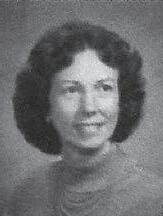

After earning her MS in 1983, Dr. LaTurno eventually directed the preclinic program in endo. She taught at both the pre-doc and graduate levels from 1976-89. She was an assistant professor when she left the faculty in 1989 after the birth of her son to practice endodontics at the office of Root Canal Specialty Associates in Brighton, Michigan, which she had joined on a part-time basis in 1986. “I think being a woman was an asset in my endodontic practice. I think I was perceived as gentle and caring.” She retired in 2012 and moved to the Grand Haven, Michigan, area to be close to family.

In reflecting on her career, Dr. LaTurno says she was “absolutely thrilled” as the number of “very bright and talented” women in dentistry grew over the years. That includes inspiring her niece, Dr. Alexis (Omer) Gallagher (DDS 2016, MS 2019 orthodontics), now a third-generation dentist in the family. A diplomate of the American Association of Endodontics, Dr. LaTurno says passing along her knowledge to the next generation of dentists brought her great satisfaction. “One of the things I am most proud of is not just my career, but all the dental students, male and female, that I helped, particularly in endodontics,” she said.
Calcott first earned an associate degree at Stephens College in Missouri, then transferred to U-M to complete a degree in zoology. She was interested in research and attended a lecture by a visiting professor from the Rockefeller Institute in New York. Impressed by his presentation, she applied to work there after graduation in 1960 and was hired as a lab technician. After three years in New York, she and three colleagues were recruited to start a new research department at the Scripps Clinic and Research Foundation in La Jolla, California, near San Diego.
Her decade of work there as a research assistant included a focus on immunology and blood serum proteins. With the Scripps research enterprise growing, Calcott decided to pursue a DDS at U-M with the intention of returning to research in dental-related immunology.
Calcott was aware of the significant increase in women in her class compared to previous years because of a growing enforcement of Title IX and Affirmative Action regulations, not just at the dental school but all across campus and the country. She remembers that, starting with
her class, the dental school had a 10 percent requirement, which meant 15 women were admitted in a class of 150. (Actual graduation numbers four years later were 14 women out of 149.)
Men in the class didn’t seem to have many problems with their female classmates, Calcott said, as evidenced by her election as President of the first-year class. Sometimes faculty members seemed especially critical of women, she said, “but I would say overall that the faculty were really, really great. It was always said among us that, well, women have to work harder. But I think each dental student had to work really hard. Dental school is really difficult, no matter who you are. I really liked my years as a student, but of course you are always glad when you are done.”
1 976 Continued
1977
7 Spring 2022 | M Dentistry FEATURES
LaTurno | Class of 1976 Class of 1977
After graduation, Calcott stayed at the dental school for a year as a Clinical Instructor in the Department of Oral Diagnosis and Radiology, then returned to the Scripps research lab in 1979. By then, research grants had changed and there was lab space but no salary for her. To support her research interests, she joined a dental practice in La Jolla and for the next two years did both research and patient care. That dual career proved untenable so she left Scripps to concentrate on the dental practice. In 1986, she started her own practice in La Jolla.
If being a female dental student had gone well, being a female dentist still had its problems in the 1980s, she said. Expanding her patient base from the previous practice was difficult. “It was society’s attitude toward women. Women were not dentists. People
were used to female physicians, but not female dentists. Most of my practice was word of mouth, so most patients who came to me knew that they were getting a woman dentist.”
Over time her patient base grew, but she said she was not as easily accepted by the male majority of dentists in the San Diego area. “That was really a battle. I was often left out of the conversation or ignored at dental meetings and study clubs. The men had all their little cliques and I could stand by myself all night and nobody would talk to me. Individual dentists were nice, but when they were in a group, say a study club, I was ignored. At dental meetings, I was often asked, ‘whose dental office do you work in?’ Sometimes I just had to smile to myself to make it OK.”
As more women chose dentistry as a career, many went into the military as a way to pay for their education and gain dentistry experience. San Diego, with a large U.S. Navy presence, brought many young female dentists to the area and they often stayed after their military commitment was finished. As the numbers grew, Calcott and several of her female colleagues started a chapter of the American Association of Women Dentists.
After retiring in 2011, Calcott has continued to live in La Jolla. She still keeps in touch with four or five friends from her dental class and remembers that time in a positive light. “I really appreciated everything I learned at Michigan,” she says. “They were tough years but it made everybody a better dentist.”
Susan Graber Robbins | Class of 1978

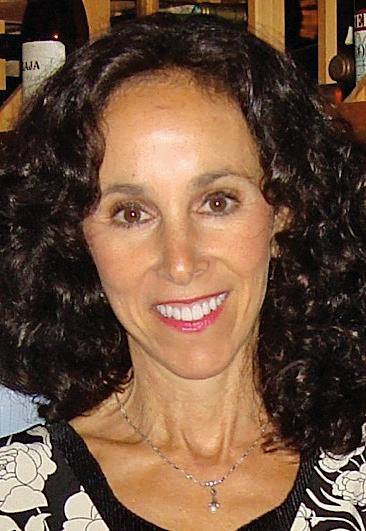
Among the many noteworthy attributes of internationally renowned orthodontist Thomas Graber was his support of women in dentistry. So when the youngest of his five children and only daughter, Susan, was considering careers, he suggested she pursue dentistry.
One of her brothers, Lee, had followed their father into orthodontics, and their grandfather, Joseph, had been a dentist, but Susan was reluctant. “My dad was a real supporter of woman power,” she said. “He had always wanted me to be in dentistry, but because of that, I was rebellious and thought, ‘no way.’ I wanted to be a veterinarian.”
Researching the requirements for veterinary medicine and thinking further about her family’s history in dentistry led to a change of heart during her first year as an undergrad at U-M. She was admitted to the U-M School of Dentistry after just two years of
undergraduate studies, one of three students in her class to receive that distinction. It meant cramming lots of science prerequisites into a short amount of undergraduate time, which was difficult, and so was reaching dental school a couple of years earlier than her classmates.
1 978
“I think it was difficult because, one, I didn’t have a degree, and, two, no one took me seriously. I was this little 20-year-old kid – a little girl in boot camp, but dental school was demanding and occasionally demeaning for everybody. The other side of the coin was that some instructors would take me under their wing, which was helpful.” Also helpful were some of the older students in the class, including the late Sondra Gunn, who became one of the wise elders that women in the class looked up to, Graber said.
Even as the gender tide was turning – the number of women in the Class of 1978 had jumped to 28 – there were times when a female support network was still necessary. “I am not one to pull the female discrimination card,” Graber said, “but there was some of that.” Several classmates told her that a faculty member had made “guy-talk” remarks about her physical appearance. He then graded her harshly when he learned that she had found out.
Another faculty member told her: “I don’t know why you are here because in five years you are going to be pregnant, barefoot in the kitchen and you’re going to waste this degree.” She adds: “And here I am practicing over 40 years later.” She emphasizes that most of the faculty treated female students with respect. In citing a couple of exceptions, she says, “I’m not complaining. More importantly, I got a wonderful education. Anywhere you go with that many people, there’s going to be someone who’s a jerk.”
After graduation, Graber and her husband, DDS classmate Lance Robbins, moved to suburban Chicago where they continue to practice separately. In the first years, Susan was an assistant professor at the University of Illinois Chicago dental school two days a
1 977
8 FEATURES
Women Who Changed the Face of Dentistry (Continued) M Dentistry | Spring 2022
week and an associate in a practice three days a week. Later, she started her own practice as she and Robbins raised their three sons, eventually moving her practice to Glenview about 15 years ago. She has been active in the Chicago Dental Society as a mediator and in other capacities, and in the North Shore Woman Dentists Study Club.
The men-women divide in dentistry was not something she thought much about in dental school, yet there was and still is a camaraderie
among the women in her dental class and in dentistry in general. Ultimately, though, dentistry is about providing excellent oral health for others, no matter the gender of the dentist.
“I love it,” said Graber, who has made lifelong friends with her patients and is now treating their children and grandchildren. “You’re helping people, you have to think about what you do, there is always something new – digital dentistry, going through the
Diana Wolf Abbott | Class of 1978

Higher education has a long tradition in Diana Abbott’s family: A grandmother graduated from college in 1908, and an uncle graduated from the Northwestern University dental school in 1918 and practiced in California. “I never had much contact with him as a child, but I remember thinking dentistry seemed like an impressive career. However, because of the times I never really thought of it for myself, being a girl.”
That mindset changed while she was majoring in psychology and taking lots of science classes at the University of Illinois. “One of my male friends from high school was a pre-dentistry major and we coincidentally were in many of the same classes together. After yet another exam where I scored higher than him, he said, ‘Darn! You are the one who should go to dental school, not me!’” She describes her reaction as: “Wow, major lightbulb over my head!”
Abbott recalls that the mid-70s were a time when there was a general excitement about women empowerment tied to societal developments like the National Organization for Women and prominent feminist leaders.
By the time she reached dental school in 1974, there was “definitely a buzz” about having 28 women in her class. She also remembers there was no locker room for women, so plywood sheets were used to divide the men’s locker room into two sections. The next year, the women had their own locker room in the basement.
“I always felt a positive camaraderie with the other women students and I think we generally had each other’s backs, something that has persisted to this day. I think we were all well aware that we were trailblazers in our field.
I do recall some males voicing the concern that we would all retire as soon as we got married and have babies, thereby ‘wasting’ a dental education. Well, I did retire after I got married and had a family – 42 years after! I practiced much longer than many of my male classmates.”
After graduation, she practiced for five years, then returned to U-M for her graduate degree in orthodontics, which she finished in
pandemic, tele-dentistry. It’s always changing with new, interesting things and fun toys. It’s rewarding because you help people. Last week I had a patient say, ‘I’m going to quit calling you Dr. Graber and call you Game Changer.’ It was because I made his veneers and it changed his self-image and changed his ‘game.’”
Much like women were game changers in dentistry, beginning in the 1970s.
1986. By then, her graduate class was evenly split between men and women, though there were still very few female mentors among the faculty.
Like Mary Ann Calcott, Abbott said the worst discrimination she faced as a woman was after she entered the working world. During interviews for associate positions, dentists often brought their wives to the job interviews. “I can only speculate on why they did this, but I never heard of any of my male colleagues having to interview with the doctor’s wife present.” She worked as an associate for a few years, then encountered a roadblock based on her gender. “When I was told by my boss that he didn’t really think I could have children while being an associate, I left and started my own practice. The University of Michigan was certainly way more progressive than the general profession at the time.”
Today, Abbott says it is a pleasure to see so many women in dentistry, including her daughter. “Sometimes, when I go to meetings, I’ll relate ‘how it used to be’ and I get stares of disbelief. The young women can’t imagine what a barrier it was to break through, and I fear they take it a bit for granted now. But women are so well-suited to this profession it is hard to imagine a time when the only way we could participate was on the other side of the chair.”
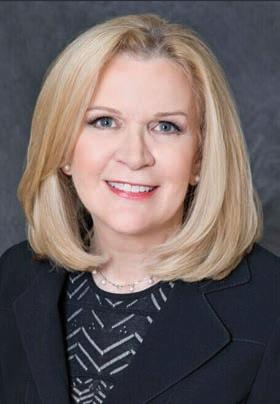
9 Spring 2022 | M Dentistry FEATURES
Continued
Marilyn Woolfolk | Class of 1978

Marilyn Woolfolk said she and her female classmates were aware it was a period of change for the field of dentistry. She praises the strength and determination of the women in her class, who navigated the difficulties of dental school with few role models to follow. Woolfolk had the additional distinction of contending with the inherent challenges of being one of the few Black dental students.

Woolfolk had planned on a career in microbiology research, earning bachelor’s and master’s degrees in that field. After obtaining her graduate degree at U-M, she worked for two years as a research assistant at the dental school in the lab of Dr. Walter Loesche He and Dr. Emerson Robinson, a faculty member in Community Dentistry, convinced Woolfolk that obtaining her DDS would be a wise career move.
Woolfolk recalls being aware of some minor gender bias always present in the background, along the lines of “Why are you going to spend time training women when they aren’t going to be as productive in the field?” But usually, the pressure and difficulties of dental school were part of the territory experienced by everyone. She
does remember some faculty at times being harsh to the point of students – both men and women – wondering, “Are they trying to weed us out rather than help us stay in?”
Like Susan Graber, Woolfolk points to the counsel of female classmates who had been out in the real world for a few years before coming to dental school – in particular, Sondra Gunn and Barbara (Chamberlain) Maxson. Woolfolk remembers countless conversations among the 28 women in the class, whether in the locker room or at lunch, that served as support sessions for whatever they encountered. “We had our lunchtime together where we could say, ‘You wouldn’t believe what happened today.’”
“We all propped each other up and told each other: Go back after it. We knew that there were some biases, but that wasn’t a deterrent. We had some special personalities with confidence. You had to be Teflon – let a lot of it roll off your shoulders and not take it personally. As we proved that women were
serious about dentistry and competitive, I think it started to open the eyes of our male colleagues. They did not see us as taking up their spot, whereas that may have been the attitude of some people.”
Early on, Woolfolk debunked the myth that women could not have a family and practice dentistry at the same time – or, in her case, be a dental student at the same time. Near the end of her first year, Woolfolk gave birth to her first child, which she believes made her the first woman to ever give birth while enrolled at the school. Not that starting a family, finding reliable daycare, and meeting the academic and clinical demands of dental school were easy. It took a special focus and organizational skills, leading to what Woolfolk calls her “personal triumph” of staying in stride and graduating on time with her entering class.
Woolfolk went on to a long career as a faculty member and administrator at the dental school, with a focus on public health, before retiring as a professor and Assistant Dean for Student Services. Last fall she was reminded that the school and profession have come a long way when she saw photos from the 50-year class reunions for the Classes of 1970 and 1971. They had a combined total of only three women among nearly 200 students.
“You forget what it was like,” Woolfolk said. “I’m glad that it is different for women now.”
With 67 women and 42 men, the Class of 2023 entered the school with the most women – and the highest ratio at 61 percent – of any class since the school was founded in 1875. Leading the class as president is Samantha Sciancalepore, who is also the president of the Schoolwide Student Council. Sciancalepore said she was surprised to learn of her class’s historical distinction when it arrived in 2019. As someone who
loves history, she researched the school and learned how its culture has shifted over time to accommodate diversity in dentistry. Here are some of her reflections about the women who came before her:
“Not a week goes by where I don’t think about what life might have looked like at the School of Dentistry in the past, especially as a woman in dentistry. We cannot fully appreciate our acceptance into the school without

10 FEATURES M Dentistry | Spring 2022
978 Women Who Changed the Face of Dentistry (Continued)
1
A Current Student From the Class of 2023 Reflects on the
Jane (Smydo) Grover | Class of 1979
Jane Grover came to dentistry by way of science and art – with maybe a slight influence from the pleasant smell of eugenol that she loved during visits to her childhood dental office.
Engineering, not dentistry, was a family profession as she grew up in the Detroit suburb of Lincoln Park. She had a natural inclination toward science, but she also liked art classes during her K-12 education. So when she learned more about the artistic aspects of dentistry, along with the predictable structure of a dentistry career, it seemed like a good fit.
At what was then the University of Detroit for her undergraduate degree, she was in the chemistry club and pre-dentistry group on a campus known for its science and engineering. “Women who had an interest in those careers were just accustomed to the fact that there weren’t many of us there,” Grover said.
So when she enrolled at the U-M School of Dentistry after only three years of undergraduate study, being in a class with only 12 percent women was not an issue. Which is not to say that there weren’t comments about women on occasion, but she remembers her classmates taking them in stride. “I thought the instructors were total professionals,” she recalls. “Sometimes there were comments
Women Who Came Before Her
acknowledging our past. Learning what it was like for dentists who graduated in the 1970s has reinforced what I knew must have been true: how the rigor of the dental school curriculum still stands, but without many of the attitudes and remarks that women often experienced.
“Without these dentists who challenged the gender barrier long before I entered school, I wonder how our education would differ
like, ‘Oh, you girls are just like my wife,’ and we just started laughing. We didn’t take it as, ‘How dare you say that to me?’ It wasn’t malicious.”
Grover remembers that Gloria Kerry, one of the few female faculty members and an accomplished researcher, was well-respected and seemed to “hold court” whenever she shared her expertise and advice with students.
“She had a family, she had a practice,” Grover said. “She was one of the truly inspirational people.”
Another highlight of dental school was that Grover’s first prophylaxis patient was the great-grandson of Lucy Hobbs Taylor, the first woman to graduate from a U.S. dental school, in 1866.
Grover used her DDS degree as a springboard to a career in public health. After graduation, she practiced at and directed a clinic for children in Jackson, Michigan. She was in private practice for several years and earned her master’s degree in Public Health at U-M, from 1987-88, in a special course for master’s candidates already in the working world. It enhanced her interest in epidemiology and various aspects of public
health. She was dental director for the Center for Family Health, a federally qualified health center in Jackson, for many years. In 2013, she joined the American Dental Association in Chicago as director of the Council on Access, Prevention, and Interprofessional Relations, a unit within the ADA’s Division of Government and Public Affairs. Today she is still at the ADA, as Senior Director of the Council for Advocacy for Access and Prevention.
Over the course of her career, she has been active in organized dentistry at both the Michigan Dental Association and ADA levels. She chaired the ADA’s Political Action Committee and served two years as an ADA vice president, and was the first woman to serve on the MDA board of trustees, in 1992, among other positions.


When Grover returns to the dental school these days, usually as a dental examiner, she smiles when she walks by the location of what was a small “changing room” that she and her female classmates used. Today’s female students have a much larger locker room, among many changes made over the years as the number of women in the dental school has grown. Grover views it as a natural evolution as the dental school kept pace with cultural changes that were taking off in the decade of the ‘70s.
“I have to say I had a very good experience there. I loved it,” Grover said. “I have no complaints. It was a great experience. It was a great time.”
today. Their commitment to confront the status quo of a male-dominated field and apply to the school was the start of a movement that has finally reached gender equity at dental schools all across the country.
“Today, I see myself as an equal among my male counterparts, but I also feel empowered when I work with female dentists on our faculty. Knowing that many of these dentists
graduated during a time that may have been less accepting of women, I thank them for their perseverance and commitment to advancing the field. They’ve proved time and time again that we deserve to have a seat at the table. I look forward to seeing how the landscape continues to change over the next 50 years!”
11 FEATURES Spring 2022 | M Dentistry
979 2023
1
Dean McCauley Named U-M Provost
School of Dentistry Dean Laurie McCauley has been appointed Provost and Executive Vice President for Academic Affairs for the University of Michigan.
The 13-month appointment is effective May 16 and runs through June 30, 2023, or until a new provost is installed. She was recommended by President Mary Sue Coleman and approved by the U-M Board of Regents at its March meeting. The current provost, Susan Collins, is leaving the university to become president and CEO of the Federal Reserve Bank of Boston.

McCauley will fill the Provost role as the university completes its search for a new president. “Dean McCauley’s proven leadership skills, depth of experience and demonstrated commitment to the University of Michigan make her ideally suited for the responsibilities of Provost and Executive Vice President for Academic Affairs,” President Coleman said. “She will be an important partner for the next president as they transition into the role and launch a search for a permanent provost.”
McCauley has served as dean since 2013. She was about to enter the final year of her second five-year term. An interim dean will be announced this spring and the school will embark on a search for a permanent dean this summer.
McCauley is the William K. and Mary Anne Najjar Professor of Periodontics and professor of dentistry in the School of Dentistry, with an additional appointment as a professor of pathology in the Medical School. She will retain her professor appointment at the dental school during and after her time as Provost is complete.
McCauley joined U-M as an assistant professor of dentistry in 1992, becoming an associate professor in 1996 and professor in 2001. From 2002-12, she chaired the Department of Periodontics and Oral Medicine. In 2002, she was appointed associate professor of pathology in the Medical School, becoming a professor in 2009.
For more than 25 years, McCauley has led an active research program in hormonal controls of bone remodeling, parathyroid hormone anabolic actions in bone and prostate cancer skeletal metastasis.
She earned all of her degrees from The Ohio State University, including a Bachelor of Science in education (certificate in dental hygiene), Doctor of Dental Surgery, Master of Science in dentistry, and a Ph.D. in veterinary pathobiology. She was in private practice limited to periodontics in Marysville, Ohio, from 1988-91.
She is a member of the National Academy of Medicine and among her many other recognitions are the inaugural Paula Stern Achievement award from the American Society for Bone and Mineral Research, a distinguished scientist award from the International Association for Dental Research, a distinguished alumna award from The Ohio State University, and the Norton M. Ross Award for Excellence in Clinical Research from the American Dental Association. She has had several visiting scientist and visiting professor appointments, including at Harvard Medical School and in Europe.
M Dentistry | Spring 2022 SCHOOL 12
SCHOOL
New Chair Appointed for POM Department
Dr. Purnima Kumar has been appointed chair of the School of Dentistry’s Department of Periodontics and Oral Medicine, effective May 1, 2022. The University of Michigan Board of Regents approved the appointment in February, finalizing an extensive search by a committee of faculty, residents and alumni that considered several highly qualified candidates.
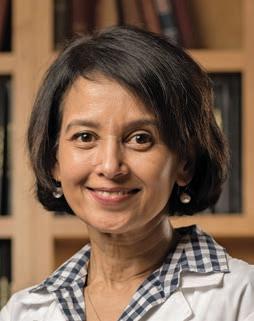
Dr. Kumar, BDS, MS, PhD, comes to the dental school from The Ohio
State University, where she was a tenured Professor of Periodontology and Chair of the Oral Biology Graduate Program. She received her dental degree from Annamalai University in India, and her master’s degree in periodontology and Ph.D. in molecular microbiology from Ohio State. Her research focuses on the oral microbiome and its interactions with the host to promote health or cause disease and the role of human behaviors in shaping this ecosystem.

She is a Diplomate of the American Board of Periodontology and a Fellow of
The Hedwig van Ameringen Executive Leadership in Academic Medicine (ELAM) program. She is an active clinician, teacher, researcher, administrator and mentor. Dr. Kumar was the Principal Investigator of the Oral Microbial Ecology Laboratory at OSU that is funded through the National Institutes of Health (NIH), the National Cancer Institute and the oral healthcare industry. She has authored over 100 papers and book chapters and serves as the co-editor of Clinical Advances in Periodontics, and as associate editor of the Journal of Periodontology, Periodontology 2000, Nature Scientific Reports and Microbiome
Annual Ida Gray Awards Celebrate Diversity
The importance of a welcoming and inclusive environment for students, patients, faculty and staff was celebrated at the dental school during its annual Diversity, Equity and Inclusion Day in February, highlighted by the annual Ida Gray Awards. They honor of the first Black woman in the country to earn a DDS when she graduated from U-M in 1890.
This year’s recipients, selected by the Diversity, Equity and Inclusion Multicultural Affairs Committee (DEI-MAC), are:
• Staff: Dr. Vidya Ramaswamy, Associate Director of Curriculum and Program Evaluation. A nominator noted the many ways that Ramaswamy’s research, curriculum development and faculty consulting have impacted the school. “Dr. Ramaswamy has helped to bring significant changes to the curriculum that have spoken directly to our core values of compassion and inclusion. Vidya was instrumental in researching and drafting a DEI statement that is now included in all course syllabi. … Her extensive wisdom of what it means to be an inclusive educator and a loving human is woven into almost every part of our curriculum, and positively impacts the profession of dentistry.”
• Student: Robert Harvey III, DDS Class of 2022. A nominator cited Harvey’s generous mentoring of other dental students from various backgrounds, his advocating for diversity in dentistry and his hands-on approach to increasing dental treatment for underserved populations. He has volunteered for numerous community dental care events and has been extensively involved in the school’s chapter of the Student National Dental Association. He has been a panelist for several information sessions for pre-dental organizations at historic black colleges, universities and high schools.
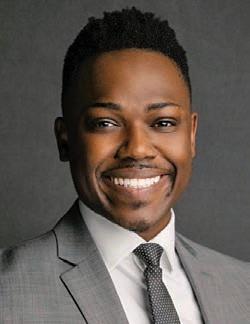
• Alumnus: Dr. Ryan Shinska (DDS 2010), International Program Director for Hope Smiles, an organization that makes quality, compassionate dental care available around the world. Shinska directed the organization’s dental program in Uganda from 2013 through late last year when he returned to the U.S. The 28 team members there work at two full-time dental clinics and 26 mobile “dental homes” where they will treat an estimated 20,000 patients this year. A nominator said “a crucial component of Ryan’s job is empowering the Ugandan team members to provide quality, sustainable dental care for communities who do not have it.”
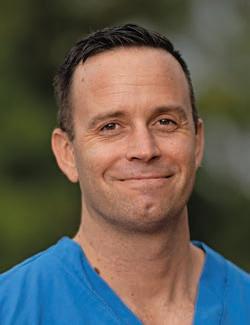
13 SCHOOL Spring 2022 | M Dentistry
Dr. Purnima Kumar
Dr. Vidya Ramaswamy
Robert Harvey III
Dr. Ryan Shinska
New Ralph Helmick Sculpture Graces School of Dentistry

A distinctive and beautiful new art installation at the School of Dentistry celebrates a piece of school history with the help of dental instruments contributed by alumni. Perennial is a sculpture by award-winning artist Ralph Helmick that hangs in the dental school’s enclosed threestory atrium. It is composed of more than 900 gold-leafed elements suspended by fine braided steel cables from a water-jet-cut aluminum frame to form a 3-D rendering of a columbine flower. Most of the hanging objects are variations of bicones, a geometric shape chosen for the appealing way it reflects light. The sculpture also includes gold-leafed dental hand instruments, such as dental mirrors and forceps, that were donated to the art project by alumni of the dental school.
The sculpture appears to be lit from within but its luminous quality is produced when light shining through the atrium skylights by day or artificial light at night is reflected off the 24 carat gold surfaces. After the sculpture’s installation in December, dental students, faculty, staff and patients have marveled at its beauty and composition, whether looking at its individual parts from two balconies next to it, or when viewing from ground level, where the best vantage point for perceiving the entire shape of the flower is from the atrium entrance of Café 32. The choice of sculpting a columbine flower at the dental school pays homage to the late Professor Albert Richards, a faculty member at the school from 19401982. A world-class expert on dental radiology, Richards used his expertise with x-rays to create artistic radiographs of flowers that show the intricate and beautiful internal elements within their external structures. The black-and-white radiographs, which became his lifelong hobby, appeared in text books, calendars, encyclopedias, museums and many magazines in this country and internationally. After retiring from the dental school,
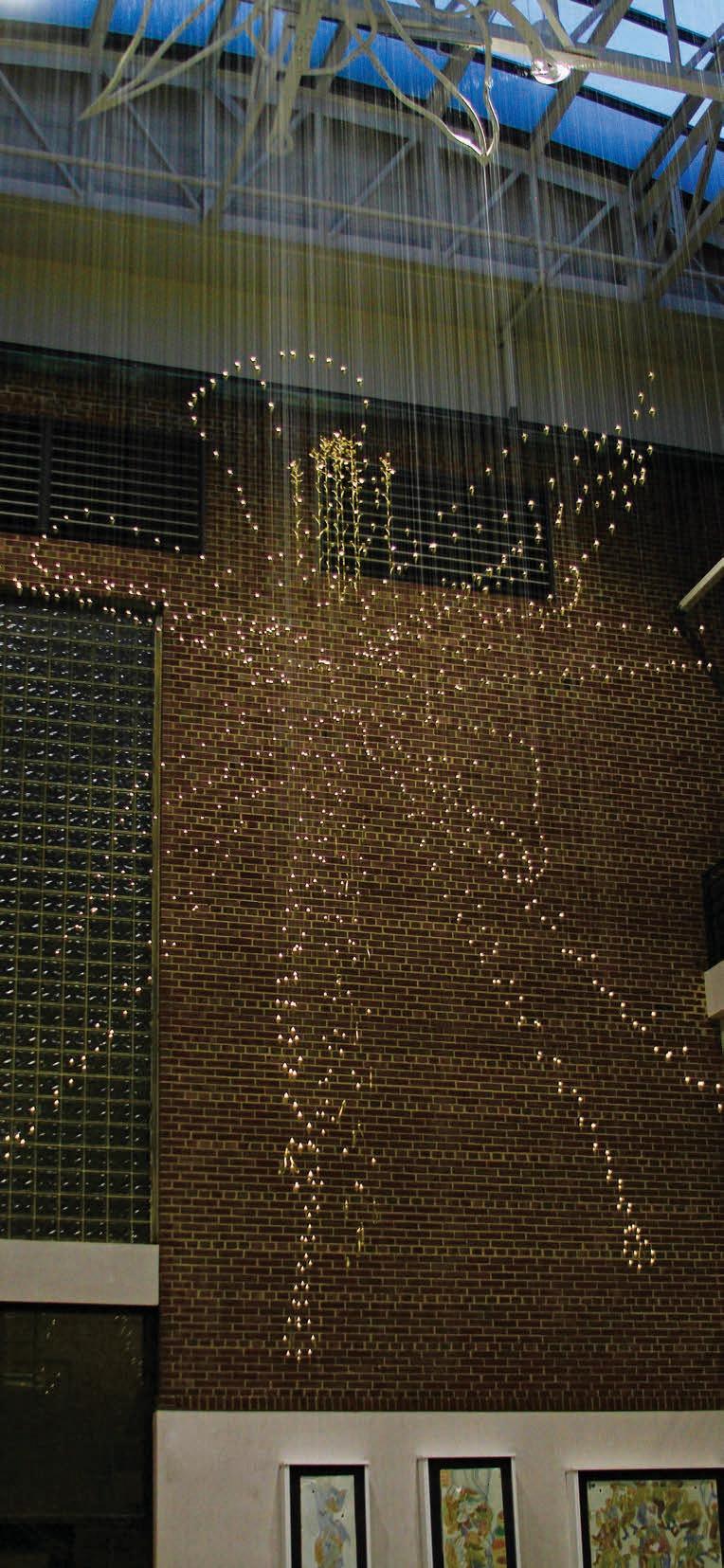 Ralph Helmick with his wife Nan Niland (center) and School of Dentistry Dean Laurie McCauley.
Ralph Helmick with his wife Nan Niland (center) and School of Dentistry Dean Laurie McCauley.
14 M Dentistry | Spring 2022 SCHOOL
Perennial by Ralph Helmick
Richards published a book in 1990, The Secret Garden, which contains 100 of his best flower radiographs. Included in that collection are two columbine images that Helmick used as models for Perennial Helmick’s commission for the School of Dentistry came about after Dean Laurie McCauley met his wife, Dr. Nan Niland, a 1979 alumna of the dental school, in 2013. McCauley learned that Helmick was an acclaimed artist and she was impressed by photos and videos of installations he has done around the country and in the United Arab Emirates. McCauley invited Helmick to create a work of art for the dental school atrium. He agreed as a way to honor his wife and the school that provided the foundation for her career as a dentist.
“One thing that has impressed me over the decades that Nan and I have been married is how devoted she is to her alma mater here,” Helmick said. “This is a very special place. When Laurie broached the subject, I thought this is a fascinating opportunity to have me acknowledge Nan and Nan acknowledge her alma mater.”
While considering what form his piece would take, Helmick embarked on the
extensive research he does for each of his public art commissions. It led him to Richards’ trademark radiographs. Not only was Richards’ work beautiful and inspiring, but Niland fondly remembered him as one of her kindest instructors.
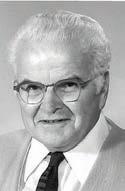
Helmick’s favorite radiograph was the columbine, for its dynamic beauty, but also for its “sculptogenic” form. He made sketches from a Richards radiograph, then worked with a programmer to create a computer-assisted-design spreadsheet. It guided the precise locations on measured cables to attach the gold-leafed bicones and dental instruments that form the columbine image. Describing the process from start to finish, Helmick calls it “making a 3-dimensional image from a 2-dimensional radiograph of a 3-dimensional flower.”

Both Helmick and Niland earned their undergraduate degrees at U-M, where they first met as Resident Assistants in the Mosher-Jordan residence hall. Years later they reconnected and married. After graduating from dental school and completing
a one-year residency at the University of Vermont Medical Center, Niland spent her entire career as a dentist in the Boston area before officially retiring earlier this year.
At a reception on April 5, Dean McCauley thanked Helmick for his generous effort on the project, which he donated to the school, as well as members of the dental school community, including alumni, who contributed to the cost of the installation. Dr. Nan Niland’s sister, Dr. Nona Niland, a University of Michigan School of Medicine alumna, made a substantial contribution toward the cost of materials and installation. McCauley also thanked those alumni who responded to her request for dental instruments to be part of the sculpture, including the family of former Professor and Director of Clinics Frank Comstock.
“This piece with its beauty, historical context, generosity from our community, a husband’s devotion – what more could you ask for in a piece of art?” McCauley said, before leading a toast: “To art, to the artists who perennially lighten our lives, to our generous community, and to colleagues who become dear friends.”
More photos and information are available on the school website at www.dent.umich. edu. More information on artist Ralph Helmick and his public art commissions is available on his website at https://helmicksculpture.com.
A collection of dental mirrors donated by alumni form the pistils at the center of the columbine.


15 SCHOOL Spring 2022 | M Dentistry
Detail of the gold-leaf bicones and one of the dental hand instruments.
Professor Albert Richards and one of his columbine radiographs.
Alumni and Development Director Named
Carrie Towns is the school’s new Director of Alumni Relations and Development, effective March 1. A development staff member at the dental school since 2008, she succeeds Rich Fetchiet, who retired in January.

In announcing the appointment, Dean Laurie McCauley cited Towns’ long-standing work in developing an extensive alumni and donor network that includes many people who are deeply committed to furthering the mission of the school. “Carrie’s sense of loyalty, sincerity and passion are evident in her approach to relationships and
has resulted in both strong philanthropic support and an active volunteer community,” McCauley said.
For the last year, Towns held the title of Campaign Director and was previously Assistant Director of Development and a Major Gifts Officer. She has been at the University of Michigan for 17 years and has a wide range of experience with the university’s alumni relations and development community. She was an integral part of the dental school’s fundraising efforts during U-M’s two most recent capital campaigns.
“I am delighted to have been selected to continue to serve the School of Dentistry in this new role,” Towns said. “My career path has been truly blessed to have worked with such wonderful mentors and colleagues like Dean McCauley and Rich Fetchiet. I am confident that our team will continue to help provide our students, faculty, staff and patients with the benefits of the Michigan Difference, which is made possible by our amazing community of alumni, donors, foundations and corporate partners.”
Towns holds a BBA from Northwood University in Midland, Michigan, and an MBA from Walden University in Minneapolis, Minnesota.
Rich Fetchiet Retires After 35 Years
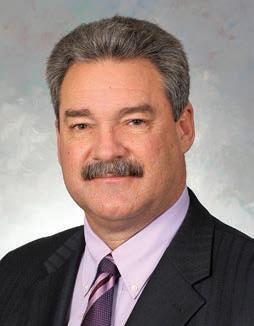
When Rich Fetchiet retired in January as Executive Director of Alumni Relations and Development at the School of Dentistry, he reflected on his 35 years of university service by compiling a “Retirement by the Numbers” to illustrate changes over those three decades.
Counting four years as Development Director at the U-M College of Pharmacy prior to joining the dental school, his tenure spanned nine U-M presidents, eight U-M development leaders and four dental school deans – Bernie Machen, Bill Kotowicz, Peter Polverini and Laurie McCauley. He led the school through four major, university-wide campaigns and a conservative estimate is that he was involved in generating $125 million in gift support over his career. Shortly after he was hired at the dental school in 1990, one of his first published messages to alumni still holds true today. He thanked the alumni for a record-setting year
for gifts to the school, which he said was particularly important as federal and state support for the university was declining and as tuition was “approaching the limit of a student’s ability to pay.”
“The profession of dentistry and the nature of oral healthcare continue to be characterized by rapid change and new discoveries, requiring that the quality of the school’s facilities, faculty and programs constantly be renewed and strengthened. Without donor support, we could not sustain the tradition of leadership and innovation that keeps Michigan at the forefront of dental education, patient care and research.”
Even as change was constant in most areas, Fetchiet said two important aspects of his career stayed the same. “First, I was surrounded by a dedicated, loyal, talented and long-serving team of professionals who lifted me up daily. Second, the depth of caring and loyalty of alumni and friends of
the school is phenomenal,” he said. “I was blessed to work in a unit where we were able to become friends with so many of our alumni.”
While he was focused on his official career, Fetchiet was also an accomplished collegiate sports official. He was inducted into the National College Baseball Hall of Fame in 2012, for a lifetime of excellence in umpiring. He umpired in three College World Series; international tournaments in Cuba, Nicaragua, Spain and Italy; and the 2000 Olympic Games in Australia. He founded the College Baseball Umpires Alliance and has long been a supervisor of college umpires for numerous conferences around the country, including the Big Ten. He also was a football referee in the Mid-American Conference and others for 30 years.
In retirement, Fetchiet is continuing to supervise umpiring, but looks forward to having more time with his family, wife Kay (U-M BSDH 1981), daughter Madeline (also at U-M in a development role), and son Matthew.
16 M Dentistry | Spring 2022 SCHOOL
Carrie Towns
Rich Fetchiet
Sindecuse Spotlight
Artifacts
from the extensive collection at the dental school’s Sindecuse Museum of Dentistry
Purpose: Prototype of a tool used to compact and shape gold fillings.
Inventor: George Frederick Green, Kalamazoo, Michigan.
Circa: 1868-1875; Patented Dec. 14, 1875.
Details: “Automatic pluggers” like this one were the earliest version of a dental gun, replacing manual mallets. This unique model, which apparently was never put into production, was powered with a circular magnet and had both the hammer and point in one assemblage. It is designed “in the general form of a pistol-stock, so that it may be conveniently held in the hand,” says the patent.

Stronger devices for compacting fillings were an important advance in dental care because the more compacted the gold was, the stronger the filling would be. And the less time it took and pain it caused, the more likely the patient would recommend the dentist to friends.
This model was patented by artist and machinist George F. Green (1830-1892), who then sold the patent to the Samuel S. White company, a well-known dental supplier. At the time, most dental tools were developed by dentists themselves, but Green was not a dentist. Green invented many mechanisms, for machines as diverse as camera shutters, trolleys, grain separators and sewing machines.
Provenance: The plugger came from a School of Dentistry library collection that was transferred to the Sindecuse. The original source was not recorded.

To see more of the Sindecuse Museum collections, go to www.sindecusemuseum.org/collectionsoverview
New Museum Director
Tamara C. Barnes has been named Curator of the Sindecuse Museum of Dentistry at the School of Dentistry.
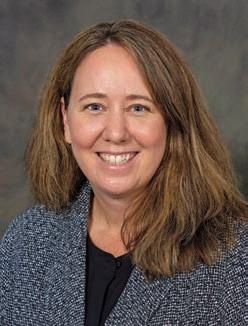
Barnes joins the museum after four years as Assistant Director for Material Culture at the Kalamazoo Valley Museum in Kalamazoo, Mich., where she managed the exhibit and collections departments. She brings more than 20 years of broad experience in museum management for arts, cultural and historical societies in Michigan, New Jersey and New York, among other locations.
Barnes will lead and manage exhibitions, programs and communications involving the museum, collection stewardship and acquisition, research and presentations. Barnes will supervise the museum staff, facilities, security and environmental conditions affecting the collection. The position also sets long-term strategy for the museum. Barnes replaces Shannon O’Dell, who retired last year.
We’re Still No. 1!
The School of Dentistry is ranked as the top dental school in the United States for the eighth consecutive year by an international publication that rates universities and their specialty programs. The 2022 QS World University Rankings by Subject, released in April, also list U-M as the fifth-best dental school in the world. The QS ranking is one of the two leading international university rankings published each year. The other, the Shanghai Rankings, most recently released in June 2021, rated the U-M dental school No. 1 in the world in Dentistry and Oral Sciences.
17 Spring 2022 | M Dentistry SCHOOL
Tamara C. Barnes
This is the new patient reception area just inside the main entrance on the north side of the dental school. With convenient access from the Fletcher Street parking structure, it is a bright and welcoming space for patients as they check-in and make their way to their appointments throughout the building.
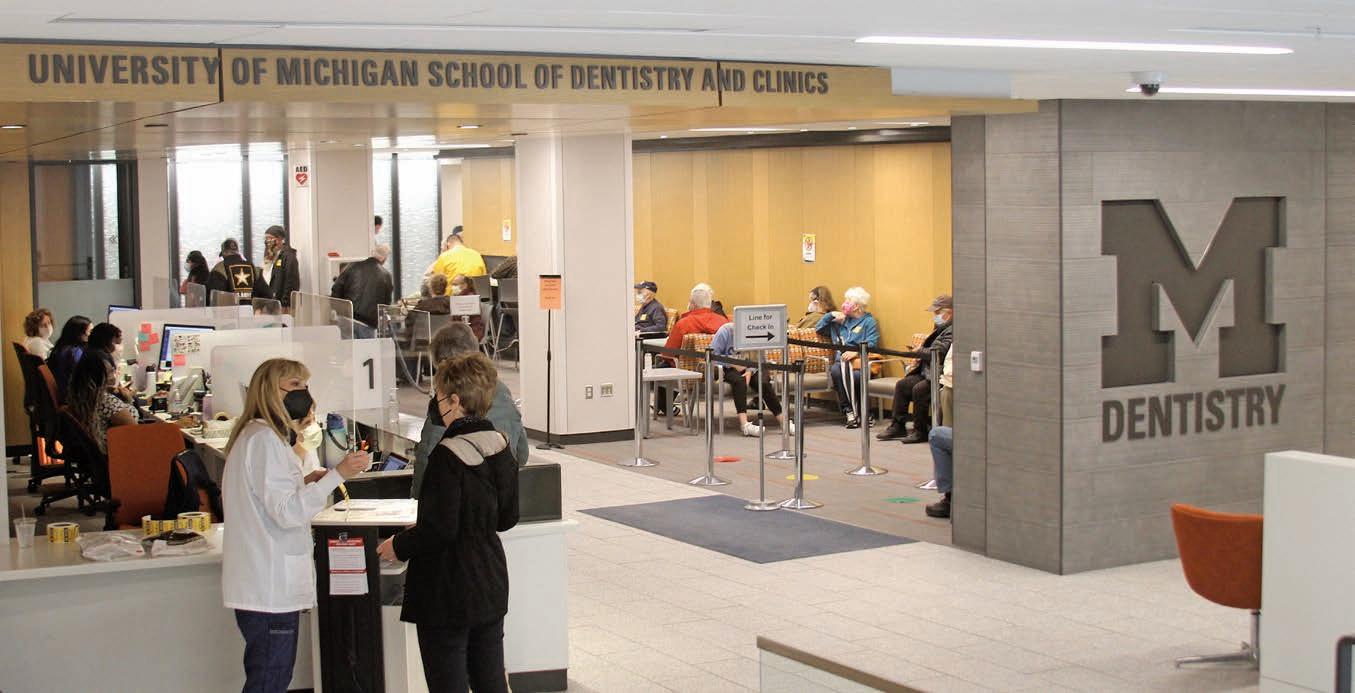
The Finish Line Approaches
The end of the school’s Blue Renew renovation and expansion project is drawing near with the final clinic undergoing renovation this spring.
The Victors East Blue Clinic (formerly the Endodontic and Periodontic Clinics on the first floor) will be completed in June.
Other recent clinic completions include the Oral and Maxillofacial Surgery Clinic and the Dental Faculty Associates, both on the second floor of the Dental Building.
As the four-year project comes to an end, plans are underway to celebrate with a special event scheduled for Friday, Sept. 16, 2022. The open-house-style event will include tours, food, music, health screenings and a formal ribbon-cutting.
Look for details in the coming months on the school’s website www.dent.umich.edu or the project site www.dent.umich.edu/blue-renew
Dr. Kerry Kaysserian (DDS 1981) poses at the operatory that bears his name in the Victors West Maize Clinic on the first floor of the dental school during a tour earlier this year. Kaysserian is one of the many alumni who have given financial gifts to support the renovation. Naming opportunities for operatories and other locations are still available. Contact the Office of Alumni Relations and Development for more information by emailing SoDalumnirelations@umich.edu or by calling 734-763-3315.

M Dentistry | Spring 2022 SCHOOL 18
Faculty Notes
Faculty member Dr. Hom-Lay Wang received the Distinguished Service Award from the American Academy of Periodontology at its annual meeting last November. The organization, which represents more than 8,000 periodontists, presents the award to members who have contributed to the specialty for more than 20 years in many areas, including pre-doctoral or post-doctoral education, committee activity, continuing education and publication. Dr. Wang is the endowed Collegiate Professor of Periodontology in the Department of Periodontics and Oral Medicine. He has served as director of the graduate periodontal program for the last 26 years.
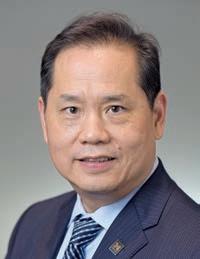
Faculty member Dr. Yuji Mishina has been appointed as the William R. Mann Professor of Dentistry. The five-year appointment, effective March 1, 2022, through Feb. 28, 2027, was approved by the U-M Board of Regents in February after he was recommended by the dental school’s Executive Committee and Dean Laurie McCauley. His work in the Department of Biologic and Materials Sciences & Prosthodontics includes an extensive combination of teaching, research and mentoring. He teaches both predoctoral and graduate students, directing courses and lecturing on topics that include prosthodontics, mineralized tissues, oral health sciences, the musculoskeletal system and
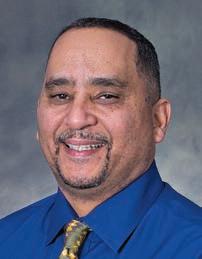

Stefanac Retires After 18 Years at SoD
development and embryogenesis. His lab focuses on molecular regulation of craniofacial development, with the objective of better understanding pathological mechanisms of gene-regulated growth and development of organs and tissues. At the school’s annual Research Day this year he received the Distinguished Faculty Mentoring Award.
Dr. Renée Duff, Associate Dean of Students at the School of Dentistry, was inducted into the American College of Dentists, a national honor society for the dental profession, in 2021. The approximately 7,000 Fellows in the ACD represent 3.5 percent of dentists. Duff has been a member of the school’s leadership team since 2013 and a faculty member since 1997. As Associate Dean of Students, she oversees the Office of Student Services, which is responsible for recruiting, retaining and fostering the educational and career development of students in the school’s academic programs, including dental, dental hygiene, graduate and DDS/PhD students.


Dr. Kristi Thomas, Director of the school’s Community Dental Clinic, and Dr. Rodney Vergotine, Clinical Associate Professor in the Department of Orthodontics and Pediatric Dentistry, were inducted into the International College of Dentists USA Section, Class of 2021. The ICD is one of the oldest and most prestigious honorary dental societies in the world. Fewer than 3 percent of dentists in the U.S. have been accepted for fellowship in the ICD.
Dr. Stephen J. Stefanac, a Clinical Professor of Dentistry and former Senior Associate Dean, retired at the end of December. As an active emeritus professor, he continues to teach treatment planning part-time as an adjunct, in both clinic and classroom. He also is finishing work, as lead author and editor, on the fourth edition of a widely used textbook, “Diagnosis and Treatment Planning in Dentistry.”
Stefanac joined the dental school faculty in 2004 as a clinical professor and associate dean for patient services. He served as the senior associate dean of the School of Dentistry from 2014-19. As part of the school’s leadership team, he was the clinical lead for implementing electronic patient records and digital imaging, and he led the clinic design and equipment selection for the $140 million Blue Renew school renovation. Nationally, he has participated extensively in dental school accreditations, journal article reviews and academic dental organizations. His service and research focuses on clinical care management, patient outcomes and care of medically compromised patients. He has mentored many students and residents and has received several student-nominated teaching awards. His commitment to students was illustrated several years ago when he took lessons to learn sign language to facilitate communication with a hearingimpaired student.
Stefanac earned his bachelor’s degree from U-M and his DDS from the University of Detroit. After working in private practice, he received his MS degree in oral diagnosis from U-M in 1987. He was a faculty member and director of oral medicine at the University of Detroit Mercy from 1987-1998. He was a faculty member and held administrative leadership positions at the University of Iowa from 1998-2004 before returning to U-M in 2004.

Spring 2022 | M Dentistry 19 FACULTY FACULTY
Dr. Hom-Lay Wang
Dr. Stephen J. Stefanac
Dr. Yuji Mishina
Dr. Renée Duff
Dr. Kristi Thomas
Dr. Rodney Vergotine

FACULTY M Dentistry | Spring 2022 20
Darnell Kaigler in front of a slide showing stem cells on a biomaterial scaffold before being implanted into a patient.
Dr. Darnell Kaigler, Jr. – Mastering Science for the Benefit of Patients
Professor Darnell Kaigler, Jr., isn’t walking the line between conducting scientific research and practicing dentistry. Instead, he is embracing the advantages of being fully immersed in both.
As the Major M. Ash Collegiate Professor of Periodontics, Kaigler shares his expertise on many levels at the School of Dentistry. He’s engaged in didactic and clinical teaching for DDS students and residents in the graduate specialties, while leading a federally-funded research group through the complex discovery journey of how to regenerate and engineer oral and maxillofacial tissues, with a particular focus on development of stem cell therapies. The research ranges from fundamental studies at the molecular level to human investigations involving clinic trials. All that taken together leaves Kaigler considering himself “a clinician-scientist-educator.”
That’s a career route he didn’t know was possible as he entered Morehouse College in Atlanta, Georgia, in the mid-1990s.The son of a prominent Detroit prosthodontist, Kaigler’s perception of dentistry through early adulthood was all about clinical practice and long hours and he wasn’t sure that was what he wanted. Early in college he had an internship at General Motors, but decided mechanical engineering wasn’t his future. Healthcare remained an option, perhaps medicine, but then an undergraduate research experience in an ecology lab showed Kaigler a new possibility – scientific research.
Department of Periodontics and Oral Medicine and was promoted to associate professor with tenure in 2016, then named the Ash Professor in 2019. He is also an associate professor of Biomedical Engineering at the College of Engineering.
The many hats Kaigler wears contribute to a busy, ever-changing schedule that is anchored around one constant – patient care at an interdisciplinary, specialty practice in downtown Detroit. The other days of the week are a constant of teaching dentistry in clinic and classroom, combined with engaging researchers in his lab as they work through plans and problems on the science side. Writing grants and working on scientific papers are also part of the equation.
The Kaigler lab’s early research, which drew national notice, focused on bone regeneration. Now it is more focused on oral tissue regeneration. Stem cells have always been a key because they can self-renew and form identical stem cells, and they also have the capacity to differentiate and produce progeny cells that are more tissue specific.
“When I’m seeing patients, I think of it in the context of science. And when I’m doing research, I think of it in the context of not just the scientific question but the clinical implications.”
“It introduced me to the culture of science, meaning you ask questions and you spend time trying to answer those questions. I thought it was pretty cool that you could spend a career asking questions and trying to find the answers to them, and that would lead to more questions to generate knowledge. That’s when I began to think: Can this be combined – research with clinical practice? Can you do both?”
The answer was yes. His father took him to meet researchers at the National Institutes of Health, where he was impressed by the scope and reach of world-class research. Around the same time, he learned that the U-M School of Dentistry, where his father had earned his master’s degree, was considering a new program that would allow students to earn dual DDS/Ph.D. degrees.
Kaigler agreed to be the first person to matriculate through the new dual DDS/Ph.D. program in Oral Health Sciences. He and faculty worked together to map out the seven-year schedule as they went forward, figuring out the timing and right mix of research and clinic time. Kaigler became the first graduate of the dual program, with his DDS in 2002 and his Ph.D. in 2004.
Kaigler went on to earn a certificates in operative dentistry and periodontology in 2006 and an MS in clinical research design and statistical analysis in 2007. In 2007, he completed a post-doctoral research fellowship in periodontology and was appointed an assistant research scientist. In 2008, he became an assistant professor in the
A practical application of the science is finding ways to heal oral tissue after procedures like tooth extraction, which is one of the most common surgical procedures in all of medicine and dentistry. If the tissue heals faster, and the bone around the site is strengthened, it enhances treatment options like placing a dental implant or other therapies.
In recent clinical trials, Kaigler brings his dentistry skills into play in tandem with his science foundation by growing stem cells in an incubator, then applying them to a gelatin sponge that is laid over the empty socket from a tooth extraction. The method has shown promise in regenerating tissue more quickly than the body does normally, but there is still much science and many clinical trials to work through before procedures will make it to the local dentist as a regular treatment option.
Ultimately, the patient in the clinic is the reason for the research, the teaching and the quest to better understand the science. In a recent presentation for the Oral Health Sciences program, Kaigler shared with the students and colleagues that he regularly receives emails from people around the country who seek help with their medical conditions, often after initial treatments failed. Kaigler said they probably Googled “stem cell therapy” for their particular condition and they found an article written about his research. They contact him hoping to join his clinical trials.
“When you are doing your research,” Kaigler told his audience, “never lose sight of that.” He said it’s easy to fall into the “bubble of academia” where success is measured in metrics like promotions, tenure, grants, published research and national awards. But the real reason for the work is the human element. “Ultimately I do what I'm doing to help patients. They are real, live people with complex clinical issues,” Kaigler said.
Spring 2022 | M Dentistry FACULTY 21 Faculty Pro f ile
RESEARCH Research Day 2022
Annual celebration returns in-person with 94 projects
The school’s annual Research Day event on Feb. 17 featured 94 posters summarizing studies by dental and dental hygiene students, graduate students in various specialties, PhD candidates, postdocs, faculty, staff and visiting scholars. The day’s keynote address was delivered by Dr. Jennifer Webster-Cyriaque, deputy director of the National Institute of Dental and Craniofacial Research (NIDCR) at the National Institutes of Health (NIH) in Bethesda, Md.
The event returned in-person at the Michigan League after being held virtually last year because of the Covid-19 pandemic. Faculty judges visited each researcher during the poster sessions and rated the quality of research, poster presentation and researchers’ oral summary of their work.

Top award recipients included:
• Ben Swanson, a dual DDS/Ph.D. student, received the Student Competition for Advancing Dental Research and its Application (SCADA) Award for his research, “Towards Regeneration of the Cranial Suture: Pore Curvature Regulates Mesenchymal Stem Cell Fate in Macroporous Tissue Engineering Scaffolds.” Faculty mentor: Yuji Mishina. The SCADA award is sponsored by the American Association for Dental, Oral, and Craniofacial Research (AADOCR) and Dentsply Sirona, a dental supply company. Swanson will represent
the school and present his research at the annual meeting and exhibition of the AADOCR in Portland, Oregon, in March 2023. This research was co-presented by Lindsey Douglas, an undergrad student at LS&A who is working with Swanson in the Mishina Lab.
• Ligia Schmitd, a Ph.D. student, received the AADOCR Travel Award to the 2022 IADR/AADOCR annual meeting and exhibition in Atlanta, Georgia, in March, where she presented her research, “Oral Cancer-Associated Nerve Injury Stimulates Axonogenesis.” Faculty mentor: Nisha D’Silva
Category 1: Clinical, Public Health, Behavioral and Education Research
• 1st Place among DDS, Hygiene, Masters and Undergrad students – Linda Liu, a fourth-year DDS student. Research Title: “Improving Oral Fluoride Retention by Chewing Calcium Supplements Before a Fluoride Rinse.” Faculty mentor: Livia Tenuta.
• 1st Place among PhD Students (DDS/PhD), Postdoctoral Trainees and Staff – Dishant Patel, staff research assistant in health policy and public health. Research Title: “Funding Trends in The Ongoing Dental Clinical Trials of the USA.” Faculty mentor: Romesh Nalliah
Erika Danella, a student in the DDS/ PhD program, discusses her research with Research Day judge Rogerio Castilho, a faculty member in Periodontics and Oral Medicine.
Category 2: Basic Science Research and Translational Science
• 1st Place among DDS, Hygiene, Masters and Undergrad students – Gefei Wang, a fourth-year DDS student. Research Title: “Insights About Oral Hygiene Habit Forming Apps.” Faculty mentor: Lynn Johnson.
• 1st Place among PhD Students (DDS/PhD) and Postdoctoral Trainees and Staff – Ligia Schmitd, a Ph.D. student. Research Title: “Oral Cancer-Associated Nerve Injury Stimulates Axonogenesis.” Faculty mentor: Nisha D’Silva
Dental Hygiene Awards:
• 1st Place Original Research Award – Meg Crowley and Katelyn Mulawa, fourthyear Dental Hygiene students. Research Title: “Oral Health Knowledge and Attitudes of Online Nurse Practitioner Student: A Pilot Study.” Advisor: Dani Rulli
• Table Clinic Award – Justin Curis and Sonia Gazi, fourth-year Dental Hygiene students. Title: “The Inflammatory Mediators Effect on Systemic Conditions: A Review of the Literature.” Advisor: Valerie Nieto.
Other Research Day awards:
• Sema Hakki, a visiting professor from Turkey, received the Janice E. Berry Prize for Excellence in Research. The family of Berry, a longtime U-M and dental school staff member who died in 2016, created the $1,000 award, also known as Jan’s Prize, to recognize a full-time researcher who may be currently experiencing a financial hardship.
• Dr. Yuji Mishina, Professor of Dentistry in the Department of Biologic and Materials Sciences & Prosthodontics, received the
M Dentistry | Spring 2022 RESEARCH 22
Distinguished Faculty Mentoring Award. It recognizes faculty who consistently impart their research knowledge and experience to students and scholars in areas of clinical, basic science and-or translational research.
• Amy Watson, Program Coordinator of the Oral Health Sciences Master’s Program and Assistant to Dr. Vesa Kaartinen, received the Research Staff Recognition Award. She was recognized as “a great team player who always goes above and
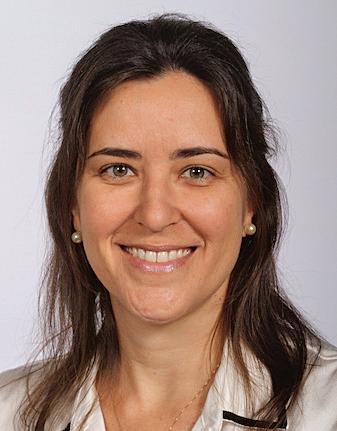
beyond” to suppor the Research Office’s initiatives and projects.
More Research Day information is available on the Research section of the school website at https://dent.umich.edu/research
SPONSORED RESEARCH AWARDS
>$50,000 from September 1, 2021, to February 28, 2022
NATIONAL INSTITUTES OF HEALTH AND OTHER FEDERAL AGENCIES
Rogerio Castilho, Marco Bottino and Cristiane Squarize: (RO1) $1,972,718. Combined Bioprinting with Stem Cell Technology to Regenerate Skin Burn Wounds.
Alexandre DaSilva: (RO1 Awarded Renewal) $3,888,130. Investigation and Modulation of the Central Mu-Opioid Mechanism in Migraine.
Joshua Emrick: (K22) $747,000. Determining the Functions of Tooth-Innervating Neurons in Dental Sensation.

Christopher Fenno: (RO1 Awarded Renewal) $3,111,505. Treponema –Host Cell and Tissue Interactions.
Renny Franceschi (Mentor) and Shawn Hallet (Trainee): (F30) $390,788. Unraveling the Cellular Dynamics of the Cranial Base Synchondroses Throughout Postnatal Development.
Jan Ching Chun Hu: (R56 Awarded Renewal) $2,373,010. Genetic Mechanisms of Amelogenesis Imperfecta.

Qiming Jin: (R44/Subaward from Cayman Chemical Co.) $760,810. Novel Small Molecule for Improved Dental Implant Osseointegration.
Kenichi Kuroda and Renny Franceschi (Co-I): (RO1 Subaward from University of Pennsylvania) $942,906. Regenerating Hyaline Cartilage Using Nanofibrous Hollow Microspheres and Synergizing TGF-B and HIF.
Laurie McCauley and Hernan Roca: (R56) $445,583. The Role of Efferocytic Macrophages in Bone Formation.
Yuji Mishina: (RO1 Subaward from University of Texas Southwest Medical Center) $747,000. Impacts of Mechanosensation and Matrix Architecture on Cell Fate Specification in Traumatic Heterotopic Ossification.
Lauren Surface: (R00) $747,000. Deciphering Mechanisms of Nitrogen-Containing Bisphosphonates.

FOUNDATIONS, INDUSTRY and OTHER AWARDS
Sharon Aronovich (Oral and Maxillofacial Surgery Foundation) $150,000. Development and Validation of an Anesthesia Simulation Training Curriculum for Oral and Maxillofacial Surgeons (AST-OMS).
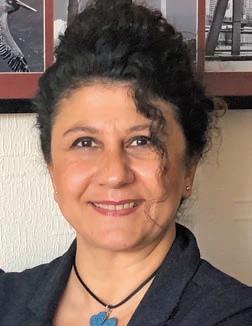
Hsun-Liang Chan (with Oliver Kripfgans, Co-I from Radiology) (Delta Dental Foundation Grant) $115,154. Longitudinal Monitoring of Microsurgical Socket Augmentation Healing with Ultrasonography – a Randomized Controlled Trial.
Hsun-Liang Chan, Berna Saglik and Gustavo Mendonca (Straumann USA) $102,957. Implant Workflow in Prosthodontics.
Mark Fitzgerald and Howard Hamerink (Delta Dental Foundation Grant) $270,000. Victors for Veterans.
Spring 2022 | M Dentistry 23 RESEARCH
Ben Swanson Sema Hakki
Ligia Schmitd
Dr. Yuji Mishina
Amy Watson
Kohn Receives National Biomaterials Award

Faculty member David Kohn received the Clemson Award for Applied Research from the Society for Biomaterials at its 2022 Annual Meeting and Exposition in Baltimore, Maryland, in April.
The society presents the award to individuals whose accomplishments include significant utilization or application of basic knowledge in science to achieve a specific goal in the field of biomaterials.
Kohn is the Natalie C. Roberts Professor of Dentistry in the Department of Biologic and Materials Sciences & Prosthodontics, and is professor of biomedical engineering in the U-M College of Engineering. He is lead Principal
Investigator for the Michigan-Pittsburgh-Wyss Regenerative Medicine Resource Center, which was established in 2017 with an $11.7 million start-up grant from NIDCR. The resource center’s leadership team includes researchers from U-M, the University of Pittsburgh and the Wyss Institute at Harvard University.
A nominator cited Kohn for his thorough approach to applied questions in his tissue engineering work. An example of the limitation in translating tissue engineering to the clinic is the inability to reproducibly synthesize a significant volume of tissue. “(Kohn) tackles this issue fundamentally: to better control cells’ response to biomaterials, he mimicked aspects of nature’s biomineralization strategies as a basis for biomaterials design,” the nominator noted.
The Society for Biomaterials is a professional society that promotes advances in biomedical materials research and development by encouragement of cooperative educational programs, clinical applications, and professional standards in the biomaterials field.
Faculty and Students Receive AADOCR Awards
A School of Dentistry faculty member and several students received awards from the American Association for Dental, Oral, and Craniofacial Research (AADOCR) at its national conference in March.
Faculty member Dr. Jacques Nör, the 2021-22 president of AADOCR, presented three Presidential Citations at the end of his term, including one to Dr. Peter Polverini, the Jonathan Taft Distinguished University Professor of Dentistry and former Dean of the school. The citation acknowledges AADOCR members who have made significant contributions and shown dedication to the association, and who have helped to further its mission through their service and commitment. “Peter has had a major impact on the training and mentoring of innumerable dental, graduate students and postdoctoral fellows, many of whom are now established faculty, academic leaders and researchers in the United States and throughout the world,” Nör said.
The citation noted that Polverini, who is also a professor of pathology at the U-M Medical School, is a former president of AADOCR, from 2013-14, and has continuously served on several committees for AADOCR and its parent organization, the International Association of Dental Research (IADR), since 1991. In 2006, he received the Distinguished Scientist Award in Oral Medicine and Pathology Research from the IADR.


As part of the conference program, Nör gave his farewell speech after leading the organization the last year. He reflected on coming
to the United States 30 years ago after earning his DDS in Brazil. His journey into higher education continued with a master’s degree in pediatric dentistry, a Ph.D. in oral health sciences and a Postdoctoral Fellowship in cancer biology, all at the U-M. Noting that his parents had only a basic education, Nör said he is thankful for the opportunity to come to the United States, work hard in his chosen field, and become president of the AADOCR. “There are very few countries in the world where an immigrant has the opportunity to become president of such a prestigious organization. This, to me, represents the American Dream. So, I am so very thankful for this opportunity to serve.”
Nör is the Donald A. Kerr Collegiate Professor of Dentistry and chair of Cariology, Restorative Sciences and Endodontics. He is also a professor of Otolaryngology at the Medical School and a professor of Biomedical Engineering at the College of Engineering. Also at the conference, held in Atlanta, Georgia, and virtually, several School of Dentistry students and residents received honors. Receiving AADOCR Student Research Fellowships were Shawn Hallett, a Ph.D./DDS student; Amy Li, a second-year dental student; and Ben Swanson, a Ph.D./DDS student. The fellowships were created to encourage dental students living in the United States to consider careers in oral health. Ligia Schmitd, a Ph.D. student who receives her degree this year, was recognized with the AADOCR Student Research Day Award, for the best presentation at the school’s Research Day in February.
24 M Dentistry | Spring 2022 RESEARCH
Dr. David Kohn
Dr. Jacques Nör
Dr. Peter Polverini
Pros Residents Win Fellowships

Prosthodontics residents Dr. Robert Ault and Dr. Bhavinkumar Patel were selected to receive the 2021 American College of Prosthodontists Education Foundation Research Fellowships. Each year, only five awards are made nationwide to support meritorious research proposals that seek to advance basic scientific and applied clinical knowledge in the area of prosthodontics.
Ault’s research proposal is titled, “Trueness and precision of economical smartphone-based virtual facebow records: A comparison between smartphone results and industrial 3D scanner results.”
Facutly Mentor: Junying Li
Patel’s research proposal is titled, “In Vitro Analysis of Two-body Wear of 3-Dimensional-Printed Occlusal Splint Materials against different antagonists of Fixed Prosthodontic Restoration Materials.”

Faculty Mentor: Marianella Sierraalta.
Swanson Earns ‘Dr. J Award’
Ben Swanson, a student in the DDS/PhD program, received the 2021 Dr. Dominic Dziewiatkowski Award last fall. It is given annually by the Department of Biologic and Materials Sciences & Prosthodontics to honor an outstanding student researcher.
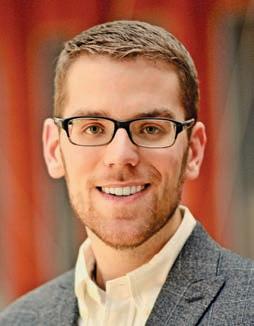

Swanson’s current research focuses on the interaction between bone-derived stem cells and novel biomaterials to elucidate means by which tailored biomaterial platforms can be used to treat disease. His work is focused at the intersection of tissue engineering, regenerative medicine, biomaterials and biomedical polymers, and controlled release technology. His mentors are Professors Peter X. Ma and Yuji Mishina
The annual award was established in 1989 in memory of Dr. Dominic Dziewiatkowski (“Dr. Jay”), who chaired the Department of Oral Biology and directed the Dental Research Institute from 1967-1972.
Symposium Award to Hutchinson
DDS/Ph.D. student Marsha-Kay Hutchinson received one of five Most Outstanding Presentation Awards in the Basic Science Research category during last fall’s annual Hinman Student Research Symposium sponsored by the College of Dentistry of the University of Tennessee Health Science Center in Memphis. Her research presentation: “Phosphorylation of TRIP13 Promotes Radiation Resistance by Enhancing DNA Repair.” Co-authors were SoD research investigator Rajat Banerjee; Emily Bellile of the U-M School of Public Health; and Hutchinson’s SoD faculty mentor, Dr. Nisha D’Silva.
The selection of a student from the SoD to compete in the Hinman Symposium is a collaboration between the Office of Research, the Pathways program and Academic Affairs. The student selected has a strong research project that has been typically presented at Research Day or through the School's Pathways program.
Contact: SODalumnirelations@umich.edu
University of Michigan | School of Dentistry 1011 N. University | Ann Arbor, MI 48109
We want to hear from you. Send us news about your
or
achievements, awards
honors.
Send Us Your News!
Spring 2022 | M Dentistry 25 RESEARCH
Research News
Dr. Robert Ault
Ben Swanson
Dr. Bhavinkumar Patel
Marsha-Kay Hutchinson
DENTAL HYGIENE
Hygiene Program Expands Class Size
The annual class size for students earning their bachelor’s degree in the Dental Hygiene Program is expanding from 32 to 40 students. The increase started in May for students entering in the Class of 2024.


The 25 percent increase is being driven by demand, said Program Director Janet Kinney, the Dr. Dorothy G. Hard Legacy Professor.

“There is a strong demand for clinical hygienists right now,” Kinney said. “When Covid-19 hit, most dental offices slowed down or some shut down. When they opened back up again over the last year and a half,
many hygienists chose not to return or retired. It’s directly in response to that need.”
Kinney said program administrators are also seeing an increased demand in the applicant pool, perhaps as the need for hygienists has been publicized by dental practices. “We’ve certainly seen more interest from highly qualified applicants than in the past,” Kinney said. “We had this new, larger incoming class filled by February 1 and we’ve never done that before.”
Dental Hygiene teamwork gets the job done. Alyssa Crisp (front) examines a patient’s teeth while Alexis Lane charts the findings on the patient’s electronic health record.
Another factor seems to be the program’s move three years ago to condense the curriculum to two years from three, by moving to a year-round class format, similar to the schedule for dental students. Previously, hygiene students had summers off and their six semesters of courses and clinical instruction took three years.
“It is appealing for students thinking about hygiene as a career to know that they can come here and get a University of Michigan bachelor’s degree in Dental Hygiene in just two years,” Kinney said. Students must complete course prerequisites before starting the program, which many do with two years at the university or by earning an associate’s degree at a community college before arriving at the dental school.
Kinney said the DH program draws students beyond the traditional hygienist track, including those who may be changing careers, want a second degree in a healthcare field, or are using the BSDH degree as a springboard for graduate studies.
26 M Dentistry | Spring 2022
DENTAL HYGIENE
Dental Hygiene student Katie Bartholomew focuses on a patient while working in one of the dental schools newly renovated clinics.
Janet Kinney
Hygiene Centennial Celebration This August
A two-day celebration of the 100th anniversary of the Dental Hygiene Program at the School of Dentistry will be held Friday and Saturday, Aug. 19-20, 2022. This event was originally scheduled for 2021, the actual 100th anniversary year, but was postponed because of the Covid-19 pandemic.

Graduates of the program are invited to join a Centennial Celebration program and luncheon on Saturday, Aug. 20, in the Grand Ballroom of the Michigan League, across the street from the dental school. Earlier that morning, members of the classes of 1970, 1971 and 1972 can attend an invitationonly Emeritus Celebration of their 50th anniversaries.
Two Continuing Education Courses –a morning session and an afternoon session – will be offered on Friday, Aug. 19, at the dental school.
More information and registration details are available on the website for the Office of Alumni Relations and Development at https://dent.umich.edu/alumni-giving Questions can be directed to the office by email at Sodalumnirelations@umich.edu or by calling (734) 763-3315
In advance of the event, Dental Hygiene graduates are invited to submit photos from their time in the program. The photos will be used as part of a video presentation at the celebration. Details of how to submit photos are included on the website listed above.
Rulli Led Planning for National ADEA Conference
Dr. Danielle Rulli, a Clinical Associate Professor in the Dental Hygiene program, chaired the Annual Session Program Committee that planned the 2022 Annual Session and Exhibition of the American Dental Education Association (ADEA), held March 19-22 in Philadelphia, Pennsylvania.

Under Rulli’s leadership, the committee worked for more than a year to collaborate with ADEA’s seven councils to finalize
myriad details of the event, under the theme of “Lifting as We Rise.” The committee’s responsibilities included adjudicating proposals for presentations, research posters and corporate participation.
Rulli, who is director of the Graduate Dental Hygiene Program, also completed a second role for ADEA, serving as the 2021-22 chair of the ADEA Council of Allied Dental Program Directors. It consists of the directors of dental hygiene, assisting
and laboratory technology education programs conducted by ADEA member institutions.
Rulli is the first member of an Allied Program to chair the ADEA planning committee for the annual conference in the history of the organization, which was founded in 1923. ADEA members include all 78 U.S. and Canadian dental schools, more than 800 allied and advanced dental education programs, more than 50 corporations and approximately 18,000 individuals.
Grad Student's Research Project Receives National Award
Research conducted by a dental hygiene student while earning her master’s degree received a national award during the National Oral Health Conference in April.
Heather Lawler received the Leverett Graduate Student Merit Award for Outstanding Achievement in Dental Public Health. Her master’s thesis research and poster, “Oral Health Literacy Education and Practice in U.S. Dental Hygiene Programs: A National Study,” received the third-place award. The award
is sponsored by the American Association of Public Health Dentistry, which meets jointly with the Association of State and Territorial Dental Directors at the annual national conference.
Lawler’s research, conducted prior to receiving her MSDH degree from the School of Dentistry in August 2021, sought to determine the extent to which Oral Health Literacy, or OHL, is being included in dental hygiene education programs across the country. Previous studies have shown a significant relationship
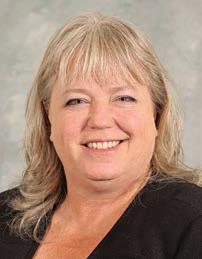
between low oral health literacy and poor oral health outcomes for patients.
Lawler queried 90 accredited dental hygiene education programs and found that several aspects of OHL education were being taught by a high percentage of programs, such as communication strategies as they relate to community health, cultural competency and special populations. However, less than half of respondents rated their graduates competent in understanding language as a determinant of health and in linking low OHL to poor health outcomes.
27 Spring 2022 | M Dentistry DENTAL HYGIENE
Dr. Danielle Rulli
Heather Lawler
STUDENTS Catching Up On White Coat Ceremonies


The symbolic celebration of entering dental classes at White Coat Ceremonies returned in-person as the school held two within five months as Covid-19 pandemic restrictions eased toward the end of last year. Usually, the school holds White Coat Ceremonies in late July, a few weeks after the new first-year class arrives. However, in 2020, in the first months of the pandemic, the Class of 2024 was limited to a virtual White Coat ceremony. Then last year, restrictions
on large crowds meant the ceremony for the Class of 2025 was stalled until an in-person event could be held the last week of October. The school then added another White Coat ceremony only five months later, in March 2022, so that the Class of 2024 could have it in-person, albeit a year and a half later than usual.
At the ceremonies, both held at Rackham Auditorium, speakers from the faculty and dental organizations offered advice for the
students. Dean Laurie McCauley praised the resilience of students in both classes when the pandemic put obstacles in their paths. “Your tenacity is important because life – and dental careers – are unpredictable journeys full of challenges that must be faced, problems that must be solved and obstacles that must be cleared. In short, life is about navigating change,” she said during the Class of 2024 ceremony.
Class of 2025 members, from left, John Ballouz, Michael Bankes and Zahraa Beydoun recite the Oath of Aspiring Dentists during their White Coat Ceremony in October 2021. In the row behind are Elise DeConinck (left) and Hadil El Chehouri.
28 M Dentistry | Spring 2022 STUDENTS
James Brady, Class of 2024, gets an assist from fourth-year student Will Buurma during the White Coat Ceremony in March 2022.
Student News
Prosthodontics Graduate Awards
The school’s Prosthodontics Graduate Program has announced two sets of scholarship recipients for 2021-22. The Joseph A. Clayton Graduate Scholarship Award recipients are Dr. Hasan Al Yousuf and Dr. McKenzie Maynor. Al Yousuf earned his DDS in his native Iraq and worked as a general dentist and teaching assistant before coming to U-M for his second dental degree and to start the Graduate Prosthodontics Program. Maynor earned her DDS from The Ohio State University, completed a general practice residency at the Detroit Veteran Affairs Medical Center and joined the U-M Graduate Prosthodontics Program in 2021 to focus on complex treatment planning. The Clayton Graduate Scholarship Fund/Foundation was created in 1998 to honor Dr. Clayton, who helped develop, direct and teach in the department’s graduate program for 25 years until his retirement in 1996.
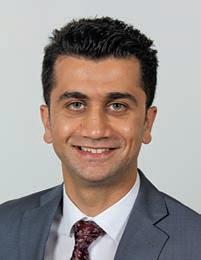
The 2021-22 Edward J. Billy Scholarship Award recipient is Dr. Christiana Onisiforou, a graduate student in prosthodontics. She grew up in Cyprus and earned a dental degree in Hungary before joining the graduate program. The Billy scholarship is named for a clinical professor of dentistry and director of Graduate Prosthodontics Program who came to the U-M dental school in 1992 as a lecturer and worked through the ranks to being named a clinical professor in 2001, retiring in 2006. Recipients of the Billy Scholarship must demonstrate excellence and enthusiasm in clinical and laboratory phases of prosthodontics, and must have completed substantial laboratory work, such as the processing of dentures, fabrication of bite splints and surgical templates.

Student leaders at SNDA
The School of Dentistry is well-represented in leadership positions in the Student National Dental Association for 2021-22.
• Jaerae Dell (D3) is Vice-President. He assists the president in overseeing the organization, helps plan the national conference and is charged with overseeing HBCU Connect, an initiative designed to foster


connections between SNDA Chapters and pre-dental students at Historically Black Colleges and Universities.
• Clarence Cochran (D2) is Treasurer-elect. He learns about the financial operations of the organization this year, then serves as Treasurer next year. To further learn about the organization, he became chair of the Membership Committee and is also either chair or member of several other committees. As Treasurer, he will be chairperson of the Budget and Finance Committee.

• Ezinne Nwadinobi (D3) is Representative to the National Dental Association House of Delegates for the 2021-22 term. She maintains close contact with the NDA and advocates for student needs during the biannual NDA House of Delegate Meetings. She also holds elections for the upcoming


executive board during the national conference, and she serves on numerous national conference committees.
• Raurie Petrich (D3) holds a position known as Corporate Round Table, or CRT, which is an entity that acts as an advisory committee to strengthen the organization’s growth and development. He works to secure funding and establish meaningful business relationships to strengthen the organization. “Dentistry is constantly progressing and the right partnerships are with corporations who embody change, innovation, and representation,” he said.
Annual Kids Clinic Returns
Second-year dental student Alyssa Evans kept 4-year-old Gabriel engaged by letting him push the buttons that raise and lower the dental chair and turn on the exam light for the chair during a break at the Give Kids a Smile Clinic held at the dental school in April.
Nearly 90 children ages 4-14 from communities in and around Washtenaw County were brought by their parents and guardians to the dental school for free dental exams and basic oral healthcare. The community service project was staffed by about 150 volunteer dental students, dental hygiene students, faculty and staff.

29 Spring 2022 | M Dentistry STUDENTS
Dr. Christiana Onisiforou
Ezinne Nwadinobi
Dr. Hasan Al Yousuf
Clarence Cochran
Jaerae Dell
Raurie Petrich
Dr. McKenzie Maynor
ALUMNI Alumni Pro f ile
Kamodia Family: Dentistry and ‘a sense of adventure in life’
It may be an understatement to say that the Kamodia family is “True Blue through and through” when it comes to the University of Michigan School of Dentistry.
The patriarch, Dr. Sanjay Kamodia, graduated from the dental school in 1989. Daughter Shalini graduated in 2015 and daughter Shivani followed with her DDS in 2018. The dental school connections don’t stop there. In 2019, Shalini teamed with a dental school classmate and close friend, Stephanie Johnson, to start a dental practice near Charlotte, North Carolina. Shivani married a dental school classmate, Aaron Barto, and they currently live in Okinawa, Japan, where he practices as a prosthodontist in the U.S. Navy.

While dentistry is obviously a core value for the Kamodias, they are an adventurous family determined to get the most out of life. Time outside of dentistry is used for things like trekking to base camp at Mt. Everest in Nepal, or going to culinary school, or becoming an advanced yoga instructor.
World-class mountains draw the Kamodias. In 2016, Sanjay climbed Mt. Kilimanjaro in Tanzania. In early 2017, Sanjay and his wife Varsha made an 18-day trek through mountain ranges in central Nepal known as the Annapurna Circuit. Later that year, Shalini went to Nepal by herself and made the arduous six-day, 80-mile climb, with a guide, to Everest Base Camp. Impressed with Shalini’s stories and beautiful photos of the adventure, Shivani and Sanjay decided to do the same, in the fall of 2018 after Shivani had graduated from dental school. Sanjay calls the family travels “having a sense of adventure in life.” And it has continued in retirement since Sanjay sold his practice in Vestal, N.Y., in early 2020. Starting that fall, with international travel limited by the Covid-19 pandemic, Sanjay and Varsha went on a 10-month drive across America in a recreational vehicle. In Florida, they liked the Tampa Bay area so much that they decided to sell their home in New York last year and move to Tampa.
Sanjay’s professional trek that led to Tampa started in the early 1980s when he earned his DDS and a master’s in oral surgery in Bombay in his native India. He practiced there and in the United Kingdom for two years, then immigrated to the U.S. and entered the U-M dental school. After graduation in 1989, he worked for a few years as an associate in Ithaca, N.Y., then started his solo general dental practice in Vestal in 1994.
It was a rewarding career for three key reasons, he says: “The satisfaction of helping people in pain, nurturing relationships with patients and their families; the challenge of learning and adapting to new skills with changing needs and techniques; and practicing three days a week gave me a good balance of work and life.”
His daughters were paying attention. “It’s ironic that my sister and I both became dentists, because our parents never once pushed us to follow this path,” Shalini said. “Of course as a rebellious teenager, I went out of my way to explore different career
M Dentistry | Spring 2022 30 ALUMNI
From left, Sanjay, Shivani, Shalini and Varsha Kamodia at Shivani’s dental school graduation in 2018.
paths, but in the end the path of dentistry was always the right fit. Growing up around my Dad’s practice, I had an opportunity to really see what it was like and ultimately I didn’t find anything else I could imagine myself doing in college. I like working with my hands, being creative, and problem-solving. Dentistry is an amazing career that allows me to do all those things and have the opportunities that come with being a business owner.”
Shalini worked at her father’s practice for three years after graduation, then in 2019 started a practice with Stephanie Johnson. They had met on the first day of dental school and became fast friends. “It’s crazy to think we ate lunch together in the courtyard of the Michigan League after head-and-neck anatomy on our first day of dental school, and now we own a business together,” Shalini says.
Shalini says dental school was about much more than dental skills. “I learned a lot of technical stuff in dental school, but what was most important was learning how to learn quickly. U-of-M encouraged me to think and to problem-solve under pressure, and these are the skills I use on a day-to-day basis.”
In her off time, she uses her cooking skills, which she enhanced by earning a culinary arts certificate from the Institute of Culinary Education in Manhattan, N.Y., during a gap year between college and dental school. “I would definitely recommend a gap year to anyone on a long educational path. It was a fun and different experience that allowed me to recharge and explore the world outside a classroom and learn a useful life skill. I’m definitely a huge foodie and I will also eat just about anything. My husband and I love to explore the new restaurants around Charlotte, but my favorite food is still pizza.”
Shivani didn’t hesitate in following her father and sister. “Following in my father’s footsteps was an easy decision after witnessing the joy and fulfillment he experienced
through his career,” Shivani said. “He absolutely loves being a dentist and I loved watching him thrive in his practice while still pursuing his passions and being present with our family. I wanted a career in healthcare that allowed me the time for compassionate patient care and time to pursue other passions. Dentistry checks all of the boxes.”

In Okinawa, Shivani is taking a break from clinical dentistry to focus on making wellness more accessible to healthcare professionals. While she was an undergraduate, she became a certified yoga instructor and used what she learned as a way to manage the stress and difficulties of dental school for herself and for others. Over time she has expanded beyond basic yoga instruction into offering workshops, online programs and immersive retreats to teach how to manage stress and prevent burnout. (Details on her website at www. drshivasana.com.)
“I believe if the science of well-being and wellness is applied to dentists, they, too, can thrive without sacrificing their mind or body.
Stress, burnout and chronic pain are still very prevalent in the profession, and I hope to be part of changing the status quo.”
The American Dental Association featured her yoga and wellness expertise in a two-part entry on its “New Dentist Blog” in January and April 2021. She co-hosts a podcast – “My Loupes Are Up Here: A Raw Discussion for Women in Dentistry” – and contributes to numerous other podcasts and websites. She also hosts a mastermind called the Creative Collective, a group of about 30 women in healthcare who gather virtually six times a year to share their stories as a way to find growth and transformation.
“This time abroad has allowed me to explore entrepreneurship while fully embodying the wellness practices that I teach,” Shivani said. “As dentists, we often spend our lives busy, jumping from one achievement to the next. I am so grateful for this opportunity to reevaluate my relationship with busyness, slow down, share my message on wellness, and explore Japan with my husband.”
Spring 2022 | M Dentistry 31 ALUMNI
Sanjay and Shivani Kamodia unfurl an M Dentistry banner at Mt. Everest Base Camp in 2018.
Reunion Weekend Honors Classes of 1970 and 1971
The School of Dentistry’s DDS and MS classes of 1970 and 1971 were celebrated as they marked the 50th anniversary of their degrees during the school’s annual Reunion Weekend last November.
About 20 members of each DDS class and three alumni who received master’s degrees in 1971 returned for the reunion. Each was presented with an emeritus medal and pin during a ceremony held at the Rackham Building. The weekend also included the school’s annual Hall of Honor induction, presentation of its Distinguished Service Award, a Continuing Education course, and a group outing to the Michigan football game vs. Indiana.
The reunion featured graduates from two years because the Covid-19 pandemic prevented a reunion weekend in 2020. In another pandemic-related change, Dental Hygiene alumni celebrating their 50-year anniversaries will be honored in August 2022 as part of a special program commemorating the 100th anniversary of the school’s Dental Hygiene Program, an event also moved back from its original schedule in 2021.
Hall of Honor Award
The 2021 honoree is Dr. Frank Comstock (DDS 1950, MS 1955). Dr. Comstock was a pillar of the School of Dentistry from 1950 to 1984 as an outstanding clinician, professor of dentistry and administrator.
The Hall of Honor Award is presented posthumously by the school’s Alumni Society Board of Governors to recognize and honor individuals who have made outstanding contributions to the profession of dentistry. Nominees must be a graduate of the DDS, Dental Hygiene, MS or PhD programs, a faculty member or a research staff member.

Since the Hall of Honor was created in 2003, 52 people have been honored with a plaque in an entrance hallway at the school.
Dr. Comstock began his career as a clinical instructor in 1950, after graduating from the dental school. He was promoted to assistant professor in 1955, associate professor in 1960 and professor in 1967. He taught in the Department of Operative Dentistry and co-wrote a widely used textbook on the subject. For 15 years he led the Graduate Restorative Program, and he also was instrumental in establishing a dental assistant program in 1961. His leadership as Director of Clinics beginning in 1969 affected nearly every student, patient and staff member since he was responsible for coordinating and scheduling use of the facility to match the needs of the curriculum. The senior DDS class honored him in 1969 with the Paul Gibbons Award for outstanding teaching. Of particular importance during Dr. Comstock’s career was his contribution to the design and construction of the dental school building that opened in 1971. He was one of a small group of administrators who worked tirelessly for

more than a decade in planning and making countless decisions that went into the project. There were no modern dental schools around the country to use as a model, so the planning group set out to design their own state-of-the-art building and clinics. When it was completed in 1971, the facility became the national model.
Two of Dr. Comstock’s children, Mark and Jeff Comstock, thanked the school for the award on behalf of their eight siblings.
Distinguished Service Award
After devotion to his family and the patients he treated during his 46-year career as a dentist, next on Dr. Peter Kelly’s list of priorities has always been service –to his profession, his community and his alma mater.
After earning his DDS and MS degrees from the University of Michigan in 1970 and 1973, he opened a practice in Marquette, Michigan, becoming the first periodontist in the Upper Peninsula. It didn’t take long for Dr. Kelly to demonstrate he was a man of action and commitment. For decades he led the Superior District Dental Society, both formally in leadership positions and informally by mentoring young dentists to become active in professional organizations and continuing education. He lectured regularly on periodontics and was a 40-year member of the Northern Michigan University
32 M Dentistry | Spring 2022 ALUMNI
Dr. Frank Comstock
Brothers Mark (left) and Jeff Comstock with Dean Laurie McCauley after the their father, Frank, was inducted into the Hall of Honor.
dent.umich.edu/alumni-giving
Pre-dental Advisory Board. Concerned about recruiting future dentists to his native U.P., he helped establish and financially support the Upper Peninsula Dental Student Scholarship Fund.
Pete and his wife Barb have contributed in countless ways to the betterment of Marquette, most notably in historical preservation and beautification for an extensive street flower program they have personally maintained for 33 years. They’ve been the city’s Citizens of the Year, and received a lifetime achievement award from the Michigan Historical Society. He is a member of the U.S. Coast Guard Auxiliary, taught safe boating and helped with numerous search-and-rescue operations on Lake Superior.
Dr. Kelly has been a tireless advocate and strong supporter of the School of Dentistry and U-M. A major donor to the school, he was an influential committee member who successfully encouraged other alumni and friends to contribute to the last three major fund-raising campaigns. The Kellys established the Peter and Barbara Kelly Periodontal Scholarship to support students, and they have hosted numerous school functions at their home in Marquette. Dean
Laurie McCauley describes Dr. Kelly as “an exceptionally dedicated alumnus who has literally said ‘yes’ to every request for service to the School of Dentistry.”

Dr. Kelly was introduced by a fellow dentist and friend, Dr. Robert “Buzz” Berube (DDS 1975), also of Marquette. Berube said Pete and Barb Kelly are so involved in community service that they have inspired countless others to follow their example and make their communities and organizations better and stronger.
In thanking the school for the award, Dr. Kelly said he and fellow alumni know what a great education they received at the University of Michigan and its School of Dentistry. He said the university and dental school are highly esteemed because of the contributions of many, not just a few. Of special importance, he said, is the continual need to attract and recruit the best and brightest students to the dental school. He urged his fellow alumni to contribute financially to scholarship funds for students. “I think that’s one way we can really help the university and the dental school – help to get outstanding students here,” he said.
Regarding his longtime community service in Marquette and for the profession of dentistry, Dr. Kelly attributed his involvement to the example set by his wife, who showed him how “a little bit of volunteering” can lead to “a great big thing” when others are inspired to join in. “Barb is the one who taught me how to volunteer and to give and to realize what a joy it is to do that,” he said.
Call for Alumni Artwork Submissions


School of Dentistry alumni: Do you have an artistic side?
The Sindecuse Museum of Dentistry is hosting a new exhibit in the fall of 2022 that explores the creative side of people working in the field of dentistry. Many professionals working in dentistry maintain creative outlets and art interests outside of their careers. Alumni are invited to submit artwork in many areas –photography, sculpture, textiles, ceramics, jewelry and mixed media. Also included are performance art –vocal and instrumental music, poetry readings, dance and theatrical creations.
Deadline for submissions: July 15, 2022. The exhibit opens in November 2022 and runs through August 2024.
More information and requirements for submissions are available on the exhibit website here – https://www. sindecusemuseum.org/exhibit-callfor-artworks – or email questions to dentalmuseum@umich.edu with the subject line ART QUESTION.
33 Spring 2022 | M Dentistry ALUMNI
Dr. Peter Kelly (center) with Dr. Robert “Buzz” Berube and Dean Laurie McCauley.
2022 Reunion Weekend is Nov. 10-12. Details available later this summer on the school website
Rickert Receives Prestigious Gies Award From ADEA
School of Dentistry alumna Dr. Jessica Rickert (DDS 1975) was presented with one of the top honors bestowed by the American Dental Education Association (ADEA) during the organization’s annual conference in Philadelphia in March.
Rickert received the William J. Gies Award for Achievement for her tireless advocacy of diversity in dentistry and especially the need for more American Indian dentists. It was one of seven Gies Awards presented for Vision, Innovation and Achievement to individuals, institutions and organizations by ADEA. The organization’s members include all 78 U.S. and Canadian dental schools, more than 800 allied and advanced dental education programs, more than 50 corporations and approximately 18,000 individuals.
Rickert, a member of the Prairie Band Potawatomi Nation, was the first female American Indian dentist when she graduated from U-M. Now retired from the practice of dentistry, she continues to frequently travel from her home in Traverse City, Michigan, to speak on diversity issues at conferences and educational institutions around the country. A founding board member of the Society of American Indian Dentists, she emphasizes the need to improve education for all ages of

Why I Give...
Dr. Steven Blanchard (DDS 1980) Professor, Department of Periodontology Indiana University School of Dentistry

A native of Muskegon, Steven Blanchard earned his undergraduate degree at Marquette University and his DDS from U-M in 1980. He entered the U.S. Air Force for what he thought would be a four-year stint. It turned into a 22-year career, including a three-year residency in periodontics at an Air Force medical center in San Antonio, Texas, and a duty assignment at the Pentagon before retiring. He then accepted an appointment as the Graduate Periodontics Program Director at the Indiana University School of Dentistry in 2002 and continued in that role through 2021. An active member of the American Board of Periodontology, he was a Director from 2009-15, the Chairman from 2014-15, and an Examiner for the oral board certification, a role he continues today. Below, he shares his memories of dental school and why he has chosen to give back financially.
“The two U-M faculty members who most influenced my career were Dr. Sigurd Ramfjord and Dr. Walter Loesche. Even though their personalities and philosophies were often on opposite ends of the spectrum regarding periodontics and periodontal treatment, they were the first that initiated and stimulated my interest in the specialty. They both taught me that we need to rely on ‘evidence-based’ and to steer away from ‘dogma.’
“I have always been grateful for the stellar dental education that I received at U-M and have felt an obligation to make some contribution to the dental school to help support
the mission. I came to realize the critical importance of alumni financial support when I joined the faculty at IU and learned that state funding and clinic income only went so far and that alumni support was critical to the operational budget of a dental school. Even small gifts add up over time.
“Recent graduates are facing significant financial debt. Over the years, most of my contributions have been for general use, but I have given to the Ronald and Donald Heys Scholarship Fund over the last several years. Both were my instructors and my wife, Jane, worked as a hygienist in their private practice during my last year in dental school.
“Any graduate from the U-M School of Dentistry has been given a special gift. Even if your four-year experience was difficult and not necessarily ‘user-friendly,’ the knowledge and skills you learned have allowed you to practice successfully and live a comfortable (and often a very comfortable) life. Giving back to the institution that helped form your professional life will assure that those who follow us have the same opportunity for continued educational and professional excellence.”
M Dentistry | Spring 2022 34 ALUMNI
Dr. Jessica Rickert
American Indian children so that they have a strong foundation for continuing into higher education and applying to dental schools or other professional schools.
In an introductory video during the award ceremony, Jane Grover of the American Dental Association, said Rickert is a visionary who sees what is possible. “She has made an impact and offered a guide map for inclusive dental education that prompts a greater awareness and understanding in the dental community of what diversity and inclusion truly is,” said Grover, a 1979 U-M DDS alumna and Director of the Council for Advocacy for Access and Prevention for the ADA.
Dental School Dean Laurie McCauley said Rickert leads by example. “Her passion lies in her desire to educate and change perceptions about what people can do, about what they can be and the impact they
can have on others,” McCauley said in the introduction. “The work that she has done is truly just beginning, and we need more like her to continue to shape the future of dentistry and dental education.”
In thanking ADEA for the award, Rickert shared beliefs from her native heritage related to the theme of individuals working together to leave a collective legacy. She cited a quote attributed to Chief Sitting Bull from 1870: “Let us put our hearts and minds together and see what kind of life we can build for our children.” She said the education of youth of all races and ethnicities is vital and must be developed by many individuals, just as a river is made of individual drops of water to become a powerful force. Indigenous people believe they are connected to those of the last seven generations, she said. “And what we do today will have an impact seven generations hence. What will that impact be?”
Alumni News
MDA Awards Honor Alumni, Faculty Member
Two alumni and a faculty member at the School of Dentistry received awards from the Michigan Dental Association this spring.

Dr. Connie Verhagen (DDS 1986, MS 1988) received the John G. Nolen Meritorious Award, MDA’s highest honor. At the MDA she has served as chair of the Committee on Dental Education, chair of the Special Committee on Health and Hazard Regulations, co-author of the MDA’s HHR Handbook and MDA Regulatory Compliance Manual, member of the MDA Board of Trustees, MDA treasurer and MDA president. She was a guiding force behind the MDA Foundation Mission of Mercy program, also serving as public health lead. At the American Dental Association, she has served as a delegate to the House of Delegates, a member of the Council on Dental Education and a member of the Commission on Dental Accreditation. Retired from practicing clinical dentistry, she serves as executive director of the Muskegon District Dental Society.


Dr. Rachel Sinacola received the Matt Uday New Dentist Leadership Award,
which recognizes a dentist within 10 years of earning their dental degree who has demonstrated substantial leadership qualities. Sinacola is an MDA Leadership Exploration and Development graduate and serves on the MDA Committee on Membership. She is an adjunct clinical assistant professor of dentistry in periodontics and oral medicine at the U-M School of Dentistry. She has also been active at the local level, serving as the editor of the Bulletin of the West Michigan Dental Society and as a member of the organization’s board and MDA House of Delegates group, as a member of the WMDDS Board, and as vice president of the Kent County Dental Society.
Dr. Diane Hoelscher, a Clinical Assistant Professor in the Department of Cariology, Restorative Sciences and Endodontics, received the MDA Dental Faculty Award for outstanding commitment to organized dentistry. Prior to her retirement in April, during her 26-year career she has taught more than 45 courses between U-M and Detroit Mercy. At U-M, she has put in place a faculty development program that focuses on new faculty education as they launch their dental education careers. She was a
department chair at Detroit Mercy for 13 years and recently served as the interim associate dean for academic affairs at U-M. She was senior vice president for professional development at the American Dental Education Association, working to improve the teaching skills of dental educators in the United States and Canada.
Continued 35 Spring 2022 | M Dentistry ALUMNI
Dr. Connie Verhagen
Dr. Rachel Sinacola
Dr. Diane Hoelscher
Alumni News (Continued)
Dr. Keith Mays (DDS 1989), Dean of the University of Minnesota School of Dentistry, completed his one-year term as chair of the American Dental Education Association Board of Directors at the organization’s annual meeting in March. Among his final duties at the conference, Mays presented a posthumous citation from the ADEA board to Dr. Lee Jones, an alumnus of the U-M dental school recognized for his longstanding commitment and contributions to diversity, equity and inclusion (DEI). Jones died in September 2021 at the age of 87. After graduating with his DDS from U-M in 1961, Jones practiced in Ann Arbor and was an instructor at the dental school. In 1973, the dental school established the Office of Minority Affairs with Jones as its director. Under his leadership, the school developed programs that increased minority enrollment and established the school as a leader in increasing diversity in dentistry. During the presentation, Mays shared a personal anecdote from when he was considering applying to dental school. In his role at the U-M dental school, Dr. Jones called Mays at 11 p.m. on a Sunday night to give him advice connected to his application to dental school. Jones recommended courses at a college in Mays’ native Detroit that would help the aspiring student to prepare for the entrance test. That sort of caring, hands-on mentorship, Mays noted, meant that by the time Jones retired, “a profound number of dentists – including 250 Black dentists – credited him for their careers.”
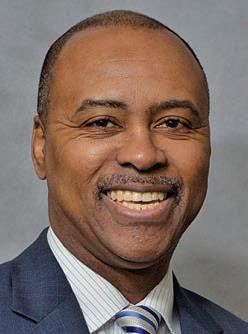
Dr. Michele Tulak-Gorecki (DDS 1990) was installed as the Ninth District Trustee of the American Dental Association last fall before proceedings of the ADA House of Delegates at the organization’s annual meeting SmileCon in Las Vegas, Nevada. Tulak-Gorecki is a general practice dentist based in Warren, Michigan. She has been an ADA member for more than 30 years and has served on the House of Delegates since 2012 and in multiple committees, including the Budget, Business and Administrative Reference Committee, the Legislative, Health, Governance and Related Matters Reference Committee and the Dental Benefits, Practice and Related Matters Reference Committee. In addition, she also served as past president of the Michigan Dental Association and the Macomb Dental Society.
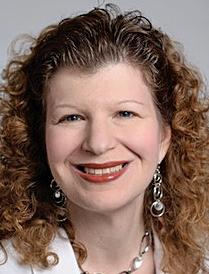
Dr. Mark Adams (DDS 1983, MS in Prosthodontics 1985) has been reappointed to the Colorado Dental Board by Gov. Jared Polis for a second four-year term. He also has been elected Chair of the board beginning in January 2023. Adams, who lives near Denver, Colo., has been an executive leader with ClearChoice Dental Implant Centers as it has grown nationally in recent years. He also is a major financial contributor to the School of Dentistry, establishing the ASK Leadership Scholarship several years ago.

In Memoriam
Dr. Robert W. Browne, an alumnus of the School of Dentistry and one of its most generous benefactors over the last 50 years, died Jan. 8, 2022, in Florida. He was 97.

Dr. Browne earned his DDS from the school in 1952 and returned for his graduate degree in orthodontics in 1959. He practiced dentistry and orthodontics for many years in Kalamazoo and Grand Rapids, Michigan, then branched out into other business ventures related to nursing homes, recreation and home health care.
His family began his obituary with this observation: “Dr. Robert W. Browne kept these words close to his heart: ‘Success usually comes to those who are too busy to be looking for it.’ Although the words belong to American philosopher and author Henry David Thoreau, Dr. Browne committed his life to the essence of their meaning. He believed that self-reliance and a tireless work ethic result in a rewarding life.”
Browne learned the value of hard work from an early age in his hometown of Coldwater, Michigan, holding numerous jobs for meager pay as he worked his way through high school and college, which was interrupted by World War II and his service as a pilot for the Army Air Corps. He returned to the University of Michigan after the war to finish his degree in chemistry and then earned his two degrees at the dental school
After many years as a practicing dentist, he and a fellow dentist, Dr. Robert Richards, and several others formed John Roberts Corporation to acquire several nursing homes in Michigan. He later was founder, chairman and CEO of Care Corporation, which acquired and built skilled and intermediate-care nursing homes around
36 M Dentistry | Spring 2022 ALUMNI
Dr. Keith Mays
Dr. Michele Tulak-Gorecki
Dr. Mark Adams
Dr. Robert W. Browne remembered for his generosity to dental school, many other causes
Memoriam
the country. The company had a real estate and recreation division that owned about 25 bowling establishments, golf courses, tennis clubs, assisted living apartments, and a large office building. In 1968, the company went public and was traded on the American stock exchange. It was sold to Owens Illinois Corporation in 1986.
Dr. Browne then served as chairman and president of Trust Investment Management Corporation (TIMCOR) in Grand Rapids and was active in various philanthropic efforts, most related to education or municipal causes, including several facilities in his hometown of Coldwater. His financial gifts spanned the University of Michigan campus, including medicine, athletics and the School of Dentistry.
The school’s Graduate Orthodontic Clinic is named for Browne after he made a major gift for its renovation in the 1990s. His financial gifts support three professorships at the school, including one that was created just last year to honor Dr. Dorothy Hard, the longtime director of the Dental Hygiene program and a colleague that Brown credited as a positive influence during his time in dental school.
“Dr. Browne was a loyal donor to our school for more than half a century,” said Dean Laurie McCauley. “The generosity of Bob and his wife Lynn was truly phenomenal, not only to our school but to many other parts of the university, his hometown and other endeavors. It was never about Bob, but about those who would benefit from his generous philanthropy. We couldn’t be more proud to have collaborated with Dr. Browne over the years and to have one of our clinics named for him. He leaves a long-lasting legacy here in our School of Dentistry, in Orthodontics and across our campus.”
Richard Fetchiet, the school’s former Executive Director of Alumni Relations and Development, worked with Browne for 30 years on various projects to benefit the school. “He was one of the most direct yet genuine people you will ever meet,” Fetchiet said. “His philosophy was to benefit faculty and students, to give them a boost because they are what the school is all about. He had a strong sense of dedication and gratitude for what the school had meant to his career and life, and he was determined to help others by giving back so they could enjoy the same educational advantages he did.”
Elizabeth (Fawcett) Bacon, (BSDH 1963), Indian Land, South Carolina, Dec. 4, 2021
George R. Baran (PhD dental materials 1976), Villanova, Pennsylvania, Feb. 5, 2022.
Mary (Everhardus) Cruickshank (BSDH 1965), Medford, Oregon, Dec. 24, 2021.
Donald J. Davies (DDS 1954), Ft. Myers, Florida, formerly of Plymouth, Michigan, June 6, 2021.
Robert V. Fontanesi (DDS 1960), Orange, California, Dec. 13, 2021.
Donald E. Granzow (DDS 1953), Hastings, Michigan, Nov. 5, 2021.
David S. Harkness (DDS 1946), Bowling Green, Ohio, Dec. 3, 2021.
Gene A. Holland (MS 1972, restorative) Flat Rock, North Carolina, Oct. 31, 2021.
Oliver F. Manzini (DDS 1955), Laurium, Michigan, Nov. 26, 2021.
Allen Methven (DDS 1976), Dayton, Oregon, March 14, 2022.
James C. Meyer (DDS 1960), Canon City, Colorado, formerly of Jackson, Michigan, Nov. 10, 2021.
Sondra Gunn, Assistant Professor Emerita of Dentistry, died Jan. 29, 2022, in Ann Arbor. She taught at the School of Dentistry from 1979 until she retired in 1996. Dr. Gunn received her bachelor's degree in secondary education in 1960, her master's degree in science for teachers in 1963, her DDS in 1978, and her master’s degree in orthodontics in 1980, all from the University of Michigan. She joined the dental school faculty in 1979 as assistant professor, serving as director of the graduate orthodontic clinic from 1990-96. Certified by the American Board of Orthodontics, she held membership and offices in several professional societies, including the Michigan and American Associations of Orthodontists, the Great Lakes Association of Orthodontists, International Association of Dental Research, the Alumni Dental Association, the Washtenaw District Dental Society, and the American Association of Women Dental Students. In addition to being a dedicated teacher in the classroom and clinic, Dr. Gunn served on several master’s degree thesis committees for graduate students in orthodontics and served on a number of school and university committees. She was a faculty advisor for the Summer Dental Student Research Program, the Minority Student Summer Program, and the Michigan Association of Women Dentists, and was a resource person for the Women in Science Program. She lectured and presented research at national meetings and published several articles in peer-reviewed journals.

Joan (Barret) Neuwirth (DH certificate 1949), Noblesville, Indiana, formerly of Davison, Michigan. Feb. 12, 2022.
Julie Ann (Forshar) Peters (BSDH 1968), Grand Rapids, Michigan, Nov. 19, 2021.
John L. “Jack” Porritt (DDS 1958, MS in Oral Surgery 1961), St. Joseph, Michigan, Oct. 27, 2021.
Thomas Saewert (DDS 1973), Kalamazoo, Michigan, Dec. 9, 2021.
Carolyn (Jeffrey) Steketee (DH certificate 1949), Grosse Pointe Farms, Michigan, Feb. 9, 2022.
Sidney J. ‘Jim’ Wise (DDS 1966), Seattle, Wash., Jan. 21, 2021,
Spring 2022 | M Dentistry ALUMNI 37
Thank You, Donors
Joey Wilmot
DDS Class of 2025
Hometown: Littleton, Colorado
Undergraduate Degree: The Ohio State University
“My early exposure to dentistry caused me to develop an intense passion to replicate the intricate work of the dental specialists who so profoundly impacted my life. The generosity of the dental school’s donors have relieved my financial burdens to ensure that my complete focus will remain on mastering a world-renowned dental curriculum. I am not only tremendously thankful, but exceedingly confident that this act of kindness will lead to superior care for my future patients.”

Address Service Requested 1011 N. University Ave. | Ann Arbor, MI 48109-1078

































 Ralph Helmick with his wife Nan Niland (center) and School of Dentistry Dean Laurie McCauley.
Ralph Helmick with his wife Nan Niland (center) and School of Dentistry Dean Laurie McCauley.
































































